
The Retrogaming Times
- The Bimonthly Retrogaming Hobbyist
Newsletter -

The Retrogaming Times
- The Bimonthly Retrogaming Hobbyist
Newsletter -
| The Retrogaming Times |
|
|
A nice diverse issue of retrogaming goodness lies before you, as is expected. At the beginning of 2017 Merman detailed the Commodore 64 games starring Sylvester Stallone, and in this issue's More C64! he does the same with the C64 games of Bruce Willis. In taking an issue away from the Apple II, Donald Lee celebrates his birthday with a trip to his local classic arcade along with a friend, then has a workplace encounter with the games of the Nintendo Entertainment System. If you're looking for endless adventure and challenge and are willing to flex your mind and imagination as well as your reflexes, "Mighty" Matt D. has the game for you! It's the massively influential Rogue and the genre it gave birth to, beckoning you to set out on your trials in this issue's Retrogaming Feels. After having only the most minor success in the USA with their Master System, Sega mounted a supreme offensive to gain a foothold in the North American console market with their Sega Genesis. With the new system came a new controller design, which Todd Friedman takes a look at in The Controller Chronicles. Gray market and independent bootleg video game development is a massive industry, especially among a few prolific Taiwanese and Chinese companies. Prolific as these developers may be within their circles, it is a part of Famicom game history that is sadly not given the attention it deserves. One of these companies, Nice Code Software, became rather well known for games that would appear on standalone plug-and-play consoles. The CoolBoy 198 in 1 Famicom multicart features over fifty individual games developed by Nice Code, and in A Pirate's Life For Me every Nice Code game on the cartridge is showcased. All that and much more are ahead in this issue of The Retrogaming Times.
I want to again remind our readers if they
have comments or questions about anything covered in the newsletter, or
there is something they would like featured in a future issue of The Retrogaming
Times, to let us know via The Retrogaming Times on Facebook at facebook.com/theretrogamingtimes
or contact me directly at trt@classicplastic.net!
Of course submissions are also always open. If you have something
ready to go, the address is the same, trt@classicplastic.net. "If
there is something you want to write about, send it in!"
|
Pintastic Pinball & Game Room Expo, July 6th - 8th 2017, Sturbridge, Massachusetts, USA
Do you love pinball? Are you looking for a little relief from the hot summer sun? Look no further than Pintastic New England, which is the first of its kind, centrally located in Sturbridge, Massachusetts. This expo is 30,000 square feet of fun for the whole family. The kids can have never-ending excitement with a caricature artist, face painting, balloon animals, magic, and relieve all of their pent-up energy with a bouncy house. The adults can bring out their inner child with over 200 pinball machines set on free play, all while enjoying an ice-cold beer.
For more information, visit https://pintasticnewengland.com/
~ ~ ~
KansasFest 2017, July 18th - 23rd, Kansas City, Missouri, USA
KansasFest is the world's only annual convention dedicated to the Apple II computer that revolutionized the personal computing industry. Held every year in Kansas City, Missouri, KansasFest offers Apple II users and retrocomputing enthusiasts the opportunity to engage in beginner and technical sessions, programming contests, exhibition halls, game tournaments, and camaraderie. Any and all Apple II users, fans, and friends are invited to attend this year's event, this year marking the 29th annual convention.
For more information, visit http://www.kansasfest.org/
~ ~ ~
California Extreme 2017, July 29th - 30th 2017, Santa Clara, California, USA
California Extreme is very pleased to officially announce the dates for this year's California Extreme Arcade and Pinball Show. It will be held on July 29-30, 2017 at the same fantastic location - the Hyatt Regency in Santa Clara, California. Please join us for our 21st show with hundreds of your favorite arcade and pinball games, both past and present, all gathered together for another fun-filled weekend of pure arcade excitement for folks of all ages!
We are working on this year's lineup of seminars, guest speakers, and other arcade-themed events that make the show so much fun each year. On that note, we are looking to you, the arcade community, for suggestions for topics and speakers. Is there something you would like to see presented (or even to present yourself)? This is your chance to let us know what you would like to see! Send us an e-mail at info@caextreme.org and let us know. We welcome all suggestions and will consider each one carefully.
Pre-registration is now open, with the registration deadline July 14th, 2017. Additionally hotel registration is now open, see the official site for details.
Start making your plans, requesting time off work, making reservations by planes, trains, automobiles, and especially trucks to come out and join us for another crazy, arcade-filled weekend!
For more information, visit http://www.caextreme.org/
~ ~ ~
Retropalooza, October 7th - 8th 2017, Arlington, Texas, USA
A celebration of all things retro! Retropalooza was started in 2013 in Arlington, Texas by a couple of guys who enjoy all things retro; from toys to music, to video games... especially video games. As video game collectors, they spent a lot of time and money looking for retro games when they figured it would be easier to bring the games to them. Thus, Retropalooza was born.
The goal of Retropalooza is to bring nerds from all walks of life together for an enjoyable, family friendly time. Good old fashioned fun with like minded people where it will always be affordable, and forever improving.
For more information, visit http://retropalooza.com/
~ ~ ~
If there is a show or event you would like
listed here, free of charge, please contact David directly at trt@classicplastic.net.
Please include a short official blurb about your event along with any relevant
links or contact information and it will be published in the next issue
of The Retrogaming Times. The event listing will remain posted until
the issue following the event date. Big or small, we want to promote
your show in our newsletter. Check out these great events, shows,
and conventions and let them know you read about them in The Retrogaming
Times!
|
So after looking at the appearances of
action hero Sylvester Stallone, this time we turn to Bruce Willis. A trio
of C64 games featured his likeness, starting with...
DIE HARD
The original Die Hard movie has gone down as a classic. John McClane must rescue the hostages - including his estranged wife Holly - from the Nakatomi Plaza, as the criminals carry out a heist during the office Christmas party.

Bruce Willis on the loading
screen of Die Hard (C64) (left), Exploring Nakatomi Plaza puts John McClane
in danger (C64) (right)
Activision's game of the film is based on the DOS version and takes an interesting approach, which is different to the action-oriented NES and PC Engine games. This is more of an adventure/exploration game. The top of the screen shows the current location while the bottom shows the objects John is carrying, including weapons and ammunition. While it does not scroll like the DOS version, the graphics are reasonable. Presentation is spiced up by some good bitmap screens (including the taunting Gruber on the Game Over screen) and short digitised sequences taken directly from the film. This includes McClane swinging on a fire hose. While it is perhaps too ambitious for 8-bit hardware, there is a challenge in working out what to do.
Rating: 4 out of 5 YIPPEE-KI-YAYS!
DIE HARD 2: DIE HARDER
The sequel saw McClane in an airport taken over by terrorists as his wife's plane circles, running out of fuel. Drawing inspiration from the film, the game uses a first-person perspective and scrolls horizontally, similar to Operation Wolf. Each of the five levels is split into three sections, ending with a boss encounter featuring tougher enemies. Civilians occasionally run past and must not be shot. Extra health and a useful bulletproof vest can be collected by shooting them. Grenades and extra weapons with faster fire rates can also be collected.

How can the same stuff
happen to the same guy more than once? Die Hard 2's loading screen (C64)
(left)
Point and shoot with
the Uzi in Die Hard 2 (C64) (right)
Although it sold well across multiple formats, this is not a good game. It also has a terrible end sequence - just a simple text screen saying YOU COMPLETED YOUR MISSION.
Rating: 2 out of 5 melon farmers.
HUDSON HAWK
This was a real flop at the box office, but I enjoyed it as a film. If you are prepared to let it play its course - with the surreal edge, the swing songs used to co-ordinate robberies and the overall plot about Leonardo da Vinci - then it is entertaining.
When it came to the game rights, Ocean Software took a chance. After big hits with RoboCop and Platoon, why not an action movie starring a bankable star? However, the development process hit a snag. Working from an early script, the game would become even more surreal. This included strange enemies such as parachuting nuns and giant Dobermans. And all through it our hero is only armed with a baseball that he can throw to stun enemies or operate switches.
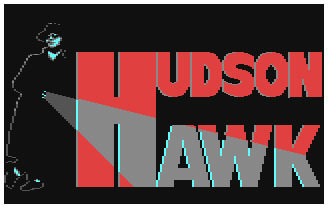
The loading screen from
Hudson Hawk (C64)
The game does follow the plot of the movie quite well. The first stage is to rob the art gallery of the precious Sforza Horse. Hudson escapes through the sewers, which becomes a much longer segment of the game. Then it is on to the Vatican to liberate the Codex of Leonardo's plans. The final task is to stop the gold-producing machine by stealing the crystal that powers it.
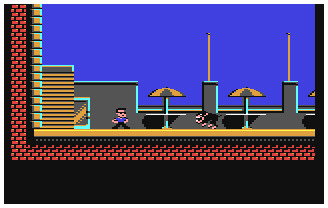
Up on the roof... The
start of Hudson Hawk (C64)
The cartoon style of the graphics works well, with the main character looking cool in his shades. Sound is limited and music above average. It's the multiload that lets the game down, with it being broken into short segments and allowing for the excellent interlude bitmaps to be loaded. The puzzles are fun, from stacking crates to reach a doorway to standing on platforms in the right order. It's not a flop, but it's not outstanding - much like the film.
Rating: 3 out of 5 Hawkmeisters.
EPILOGUE
Bruce Willis would go on to star in more games. Among the more notable examples is APOCALYPSE for the PlayStation. Bruce was involved from day one, with his likeness used for the main character and his voice recorded.
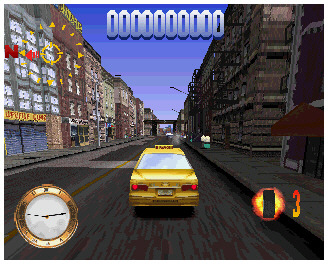
Driving the taxi in one
of three mini-games from Die Hard Trilogy (PlayStation)
But among the best PlayStation tie-ins
was DIE HARD TRILOGY, which has a C64 link. Designer Simon Pick
was also a C64 programmer. With three distinct game styles (on-foot third-person
shooter, 3D driving and first-person crosshair shooter) it packs a real
punch.
|
Dungeons and Dragons, the enduring pencil and paper fantasy role-playing game created by Gary Gygax and Dave Arneson, first appeared in 1974. I also first appeared in 1974, but am slightly less famous. At any rate, by the late 70's and early 80's, teenagers all over were rolling the oddly shaped dice and talking of minotaurs and goblins until the wee hours of the morning. The game had no pieces, board, cards, or other tokens to represent the action. All of the action took place in the players' minds - guided by rulebooks and game "modules" which provided the setting. Papers, pencils, and dice were all we needed to create our own Tolkein-esque adventures.
D&D, as it came to be known, was especially popular amongst high school and college students. It requires an active imagination, lots of reading, light number crunching, and bookkeeping. The imagination stays firmly in the wheelhouse of the player, but the rest of requirements are a perfect match for a computer. The two things were destined to come together, and one of the earliest incarnations of this happened at the University of California Santa Cruz when Michael Toy and Glenn Wichman worked to develop a text-based game that incorporated elements of high fantasy into a game that would be different each time it was played.
That game came to be Rogue. It ran on Unix based mainframes of the day, which was the type of computer typically used at Universities and large businesses. It had to be text-based mainly from necessity - those computers did not have graphical displays. Rogue takes the unique approach of making heavy use of text formatting to "draw" a dungeon using nothing but text, and represents everything in that dungeon, such as players, monsters, and of course loot, as single letters or symbols. Gold is a dollar sign. Potions are represented with a exclamation point. Scrolls are question marks. And monsters? Why, there are so many monsters that nearly every letter of the alphabet is used to represent them. Enough games of Rogue and you'll learn to fear an "M". Some players, especially those approaching it for the first time, will find the display off-putting, but I find it helps the imagination much more than any graphical representation ever could.
Much like descriptive text adventures, you will draw your own pictures of the action. That really is a big source of fun. The screen may show an exclamation point moving towards a capital D, but you will, in your mind's eye, see a potion of paralysis sailing through the air to smash on the head of a troll, freezing him in his tracks before you rush in to hack at him with your broad sword. Yes, there is a learning curve. The cryptic text and symbols will be utter nonsense to the first time player. Keep at it - the feeling of mastery and understanding that comes from practice is well worth effort, and is one of the most satisfying to be found in gaming.
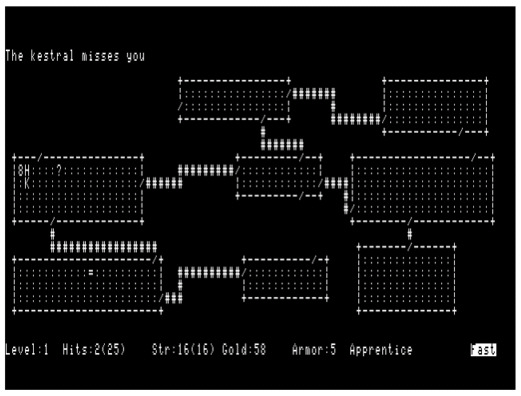
It might look suspiciously
boring - trust me, excitement aplenty.
Rogue was distributed with a version of Unix for a while, where it gained popularity. Later, it was commercialized and published for home computers by Epyx. That is how I came to discover it, when I picked up this box at our local Radio Shack:
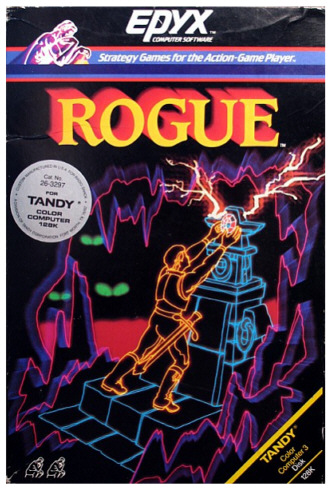
It ran on our trusty Color Computer 3, which was packed with 512K RAM so we could enjoy an enhanced version of the game that allowed for custom text characters to represent the dungeon walls. The CoCo 3 could run a Unix-like operating system called OS-9, which Rogue used. The game was only distributed on disk, and included a bare-bones version of the operating system. An RGB monitor was also needed to play the game in 80-column text mode. Everything about the game seemed advanced to me - disk drives, a half-megabyte of memory and monitor (as opposed to a TV set) may seem pretty hokey at this point, but this was a high end setup for its time. How could all this be needed for a game that does not even have graphics, much less sound?
The answer is depth.
The objective is to guide your adventurer down to the bottom of a dungeon. The dungeon layout is unknown to you, and always will be at the start of a new game. Rogue is procedurally generated, which basically means that the computer program generates a unique game world every time you play. It is tempting to think of this as being a random world, but there is much more to it than that. The dungeons, and the contents of them, are crafted such that they are always playable - simple randomness would result in overpowered monsters facing the player down before they have a chance to power up, dead ends, and other game-breaking events. The dungeon layout is not the only aspect of the game that is unique each time - a brown potion, for example, may grant the player invisibility one game, and poison the next. As you discover what is what, it is logged so the next time you pick up a brown potion it will automatically be properly identified.
This makes for a "forever" game. Rogue is always different - something that I had a hard time grasping at first when I first played it many years ago. But when I did - wow! Starting a new game is a feeling of a fresh start unlike any other in gaming. Great riches, vast worlds, and untold danger await to be discovered every time. The objective is to get to the bottom of the dungeon (many levels down), retrieve the Amulet of Yendor, and bring it back up the dungeon to the surface. Sounds simple, and of course is in reality terribly difficult. The fun of discovery is fraught with risk. Will this scroll I just picked up engulf me in fire when I read it, or will it grant additional protection to my armor? You can mitigate the risk with a scroll of identify - when one is found and discovered. The sense of discovery is vital to the fun of Rogue.
Rogue is turn-based, simply meaning that the game does not progress without input from the player. I often go from eagerly tapping away at the direction keys to carefully evaluating each keystroke as I face down multiple foes, where every weapon strike counts. Rogue punishes the careless player, and this hard lesson never seems to sink in for me. The urge to rush forward can quickly be replaced with feelings of regret when a Troll dishes out a beatdown after he manages to get between you and the only door in the room!
Rouge introduced something else to role-playing-games that can cause both excitement and frustration - permadeath. That is, permanent death. The rule for RPG's is "save often." That will not help one bit in Rogue - certainly, you can save, but doing so ends the game immediately. Reloading will bring you right back where you left off, at the cost of wiping the saved game file. Rogue is not meant to be a single adventure that last a few weeks and is then over, and I'd recommend against attempts to circumvent this by backing up your save game file. The game was made this way on purpose - accept the danger and go with the flow. The feels produced from this are what it is all about!
Few games start their own genre - but Rogue is one. "Rogue-like" has come to mean any game that offers these key features of procedurally generated environments and permadeath. These games still are popular today - look no further than the Diablo series to see evidence of this. No Man's Sky, setting aside its controversial marketing, is an example of extending the procedurally generated environment far past a dungeon to an entire galaxy. Rogue Legacy is a more obvious tip of the hat to the original.
For you, dear retro-gamer, I need only recommend a more direct "sequel." Nethack, which expands on the idea of Rogue without leaving its text based look and keyboard input behind, is an incarnation of Rogue that is, quite frankly, the epitome of a forever game. Nethack adds so many features and so much depth to Rogue it quite literally takes hundreds of pages to explain it all. It carries on the legacy of the original game, and has been ported to nearly every device imaginable. I actually played it so heavily on my first smartphone (a Motorola Droid with slide out keyboard) that I wore away the ink on some of the keys. It manages to be as approachable as the original Rogue, with so much depth you could still be playing it after 20 years. I know I have.
You only need one link for Nethack - and
Nethack is all you need. The game is still being developed and improved
on, many years after its original release. If that isn't a forever
game, I don't know what is:
http://www.nethack.org
|
The topic is definitely not about the Apple
II! The two topics of discussion this time are my birthday weekend
from a few weeks ago and the NES Classic system.
BIRTHDAY WEEKEND
My birthday came and went a few weeks ago. At my age, it's not a huge thing for me to "celebrate my birthday." It's more of a an excuse to get together with friends and hang out. I had lunches with friends leading up to my birthday. Since my birthday fell on a Saturday, I played basketball with friends like I normally do. After basketball, I met up with my friend and went to the High Scores Arcade in Alameda, CA (http://www.highscoresarcade.com).
I believe I've written about the High Scores Arcade before so I wont talk about their story. You can go to the website listed above and read the story about the place if this is the first time you've heard about the arcade.
The reason I wanted to go to High Scores for my birthday was because I had my friend with me. The prior time I had visited the arcade, I was with my mom. My mom has some health issues and it's a challenge to take her out for long periods of time. So I barely spent an hour at the arcade during my first visit. If this was the old days when my mom was younger, she might have actually played some games. She used to be able to play Pac-Man among other games.
With my old high school friend with me, we arrived fairly late in the evening (around 8:30 PM) and stayed until closing at 11 PM. We played several games together including The Simpsons, Track and Field, and Terminator. Individually, I played Galaga, Star Wars, BurgerTime, Robotron, and several other classic games. It was a nice way to pass several hours reliving the old days at an arcade.
Admittedly, now that I'm older, the excitement of going to the arcade isn't quite the same as when we were young. However, going to High Scores underscores what I've written before about arcades. Arcades are less about the games and more of a community or social center. The games bring people together and do something fun together.
My friend and I went to dinner afterward and just talked about the games. It was a good birthday weekend. If you're interested in seeing the arcade "live," have a look my birthday video I put together:
https://youtu.be/RYZmCeqyM5I?t=5m2s
As an aside, as my friend and I made our
way to the arcade, I ran into a a guy I knew that I hadn't seen in a while.
It was great to see him but totally weird timing. Again, arcades
do bring people together! :)
NES CLASSIC
I don't know why a co-worker brought the NES Classic into the office on a Friday. It was my first exposure to the system since I didn't own the original NES back in the day. Since it was fun to play, I decided to look up information on the system that day. Of course, I found out Nintendo was discontinuing the NES Classic! So that sucks.
How were the games? I played Donkey Kong, Mario Bros., Double Dragon, Galaga and Tecmo Bowl. Double Dragon was fun for two players. As a fan of the arcade Galaga, I found the NES version a tad slow and the flight patterns of the aliens a bit different than the arcade version. Tecmo Bowl was fun once I figured out how to play. The original Mario Bros. was cool. I've played the arcade version, the Atari 5200 and the Apple II versions. The game play was about the same and it was fun though I got through the first few levels pretty quickly. Donkey Kong is Donkey Kong.
I think the NES Classic is cool for the
nostalgia factor but I could see boredom gathering quickly on some games.
That being said, it would be nice to pick up one for my house! Not
sure I'll be able to find one given the big demand and lack of supply but
we'll see.
|
Nintendo rules the mid to late 1980's and at that time there was not any real competition for the home console market. Sega had an 8-bit console system to try to compete against the NES but could never keep up. In 1989 Sega unveiled the system that would finally take over the home console market in America. It was the Sega Genesis. This was a 16-bit system that would market itself as the system that could do what "Nintendon't." The sleek black system would be home to classic games such as Sonic the Hedgehog, Golden Axe, Altered Beast and Mortal Kombat. The controller for this system would stick to the basics and was designed to look like the future of gaming. Just like its counterpart of Nintendo, it would have the directional pad and an A and B button. The difference that would be significant was the addition of the C button.
The look of the Sega Genesis controller was pretty cool at the time. It looked futuristic with curved edges and a shiny black cover. The controller pad was not only up, down, left and right but diagonal as well. The Start button would be white and located above the buttons. The feel of the controller was the perfect size and weight. It felt very comfortable to the gamer and would be easy to use first time playing any game. Some may argue that the cord length was a bit too short but was standard compared to other systems of that era. Sega knew they needed a game that would be exciting and easy to play to capture the market. They also knew they had a big name to compete against. That name was Mario for Nintendo. Sega may have been the only company to have, for at least a brief moment, taken down the famous plumber. The game would be Sonic the Hedgehog and would attract the attention of gamers of all ages.
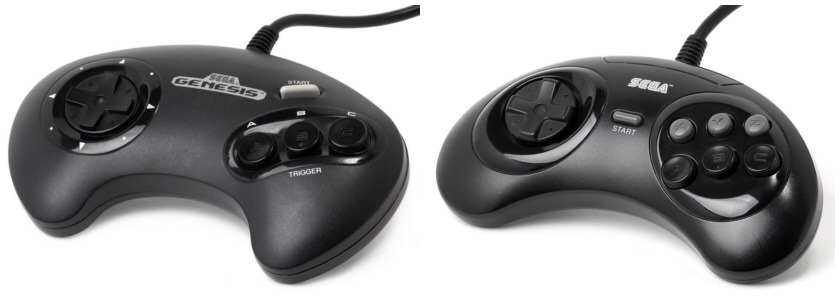
Sega Genesis 3 Button
Control Pad (left), Sega Genesis 6 Button Control Pad (right)
Released two years after the Genesis arrived in America, Sonic the Hedgehog would be the title that would help sell the Sega Genesis system to fans of every age. Marketing of Sonic took off just as well as Mario had done for Nintendo. The only way to play Sonic was on the Sega Genesis. The best part of Sonic was it was a simple side scrolling game that would be easy to control except for one thing, it was super-fast. Controlling Sonic was easy, as was using the A, B or C button to jump or do a super roll attack by holding down the button. You had many ways to complete the levels. Throughout your journey, you would collect rings and supersonic shoes to move faster. Shields and extra men were other items hidden among the levels. There were hidden animals you would need to release as well and they would meet you at the end of the level. Getting over 50 rings in the level and jumping through the large ring at the end would send you to a bonus round to get a hidden gem. Collecting all the gems would be a challenge to the average gamer. This made the game exciting and entertaining each time it was played.
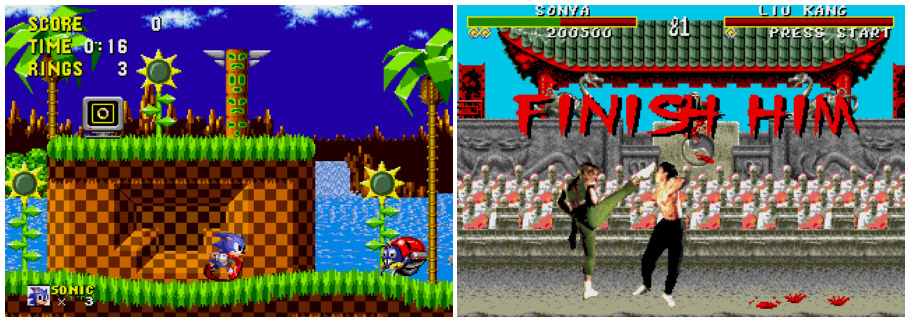
Sonic the Hedgehog (left),
Mortal Kombat with uncensored code active (right)
Another game that would break boundaries and put Genesis on the map is Mortal Kombat. This was the first version of the game that, by using a code, included the blood and fatalities from the arcade version. The controls of the Genesis version were pretty easy and to learn the combos took only a few times of playing to understand. Unlike the arcade version with additional buttons, the three-button controller added simplicity to the excitement of fighting against friends and the computer. Mortal Kombat for the genesis sparked a new form of game violence that parents would attempt to control and eliminate from store shelves. This helped begin a rating system for video games. In part because of to Sega and Mortal Kombat, all games now have a rating on them and and age restrictions on violent titles.
The Sega Genesis controller also works on the original Sega Master System console. The plug is the same size and shape and if you happen to have a Master System without a controller, the Genesis one will work on it for most games. The buttons are different due to that the Master System only had two buttons, but it is easy to pick up on.
Down the road, Sega decided eventually to compete with the Super Nintendo control pad and make a controller with 6 buttons. They added X, Y and Z buttons above the A, B and C buttons. They also made the controller slimmer and sleeker looking, making the controller even lighter than the original. I still prefer the original controller with three buttons, but some games such as Revenge of Shinobi and Mortal Kombat took advantage of the extra buttons and made the game more like the Arcade version.
Some of the positives of the Genesis controller are its shape and simplicity. This controller is one of the last to have simple controls and buttons before the next generation created analog and multiple button controllers. The cord length is good for the time since sitting close to the TV was the norm then. Negatives on the controller are multiple direction pad for some games. Sometimes it is hard to distinguish if you are going to side to side or diagonal. You need to be very precise on the way you press the directional pad. Wear and tear on the controller causes the buttons to become unresponsive and the directional pad to stick. But overall the Sega Genesis controller is still one of the nicest controllers made in its era.
Next issue we will discuss the "paper weight"
of all controllers. The original XBOX controller. If you thought
your controllers of the past were getting big, you have not seen anything
yet.
|
Welcome back as we continue our voyage with the CoolBoy Real Game 198 in 1 bootleg Famicom multicart. If this is your first journey with us, a bootleg pirate multicart is a video game cartridge containing multiple games that would otherwise have single cartridge retail releases. Pirate multicarts have become bigger and better over the past couple years. Although these days you have options such as flash memory cartridges if you want to play a bunch of games off a single cartridge, there's just something about these bootlegs that appeal to me. I've found collecting multicarts a fun collecting sub genre since the early to mid 2000's. Two of the currently most popular multicarts are branded under the "CoolBoy" name and are generally known as "198 in 1 Real Game" and "400 in 1 Real Game" and these cartridges are usually sold together as a pair.
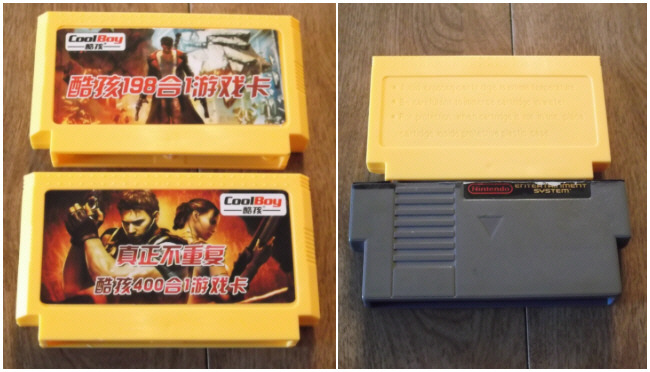
CoolBoy "198 in 1" and
"400 in 1" cartridges along with a custom made Famicom to NES converter
While the 400 in 1 cartridge contains more total games, I find that the 198 in 1 contains a more interesting mix of titles with less filler. This is due to the 400 in 1 cartridge containing more pirate originals including a rather large library of games released by Thin Chen Enterprise, the Taiwanese company better known as Sachen, history's most prolific producer of unlicensed Famicom games. While these games are an interesting collecting sub-genre onto themselves, and a sadly forgotten part of modern NES and Famicom collector culture, they're not necessarily all that fun to play. It should also be said that the back half of the game list for each cartridge is generally filled with these type of Taiwanese and Chinese pirate original games. The 198 in 1 cartridge isn't too bad in this respect, with fifty or so games falling into this category.
This scope of this ongoing column is to quickly evaluate the 198 in 1 cartridge, fifteen games at a time, until the entire list is completed. Additionally each issue will also evaluate a single game from the 400 in 1 cartridge that does not appear on the 198 in 1 counterpart. For the entire duration of this column, each cartridge will be played on an original toaster-style North American NES console. To convert the bootleg Famicom cartridges for play the NES, I will be using a Famicom to NES converter cartridge built from parts out of an early release copy of Gyromite. As a final note, many of the games contained on these bootleg cartridges have their title screens altered to strip away any copyright dates or the like.
Now, back on to high seas and high excitement!
For this journey we'll be heading into unknown waters. A substantial portion of the games contained on the 198 in 1 cartridge were developed by a Chinese company known as Nice Code Software, also known as Xi'an Dongxin Software Company. Nice Code is a fairly prolific developer, as Chinese outfits go that make games for Famicom hardware, developing games for many other gray market and bootleg publishers. The vast majority of their games tend to be found hard coded into Famicom clone hardware but on occasion they show up on bootleg cartridges. In the case of the 198 in 1 cartridge, this is a pirate outfit pirating another pirate outfit's games. In an effort to clear out this large block of titles for the open waters of genuine retail Famicom and NES titles ahead, every Nice Code game on the multicart will be covered this issue, fifty-five games in all! To help wash the seawater out of my mouth, we'll also be taking a look at a really good game on the 400 in 1 cartridge as usual.
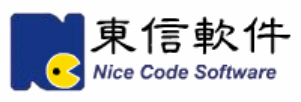
Even Nice Code's logo
is a rip-off another company's assets, in this case Namco
Now the Nice Code games really aren't very good but compared to some of the more widely known and notorious quickie games for the platform, like those featured on Active Enterprises' Action 52 for instance, they at least represent a reasonable level of technical understanding of how to program for the Famicom hardware. Some of them are decent, some are passable, and some are flat out terrible but all of them at least work correctly - for the most part. I may not enjoy how some of these games play, but Nice Code Software's titles were at least polished to the point where they don't kill you immediately or won't load correctly or have controls that don't function. At the very least the designer and programmer (who were probably the same person) of each of these games got them running to a state where they could be played. Most of these games were created to fill out the game lists of Famicom clone hardware, and with that said you can certainly do a lot worse, like the aforementioned Action 52.
A huge thank you must be given to BootlegGames
Wiki (http://bootleggames.wikia.com) for the information contained
in their archives concerning these pirate original games. While not
an absolute authority on the matter, if you are interested in bootleg video
games for classic hardware their database is a solid jumping off point.
Pirate original games such as these are a part of Famicom and NES history
that is largely unknown and sites like BootlegGames Wiki help document
it for academic prosperity.
CoolBoy Real Game 198 in 1, Games 92, 98 - 150, 154:
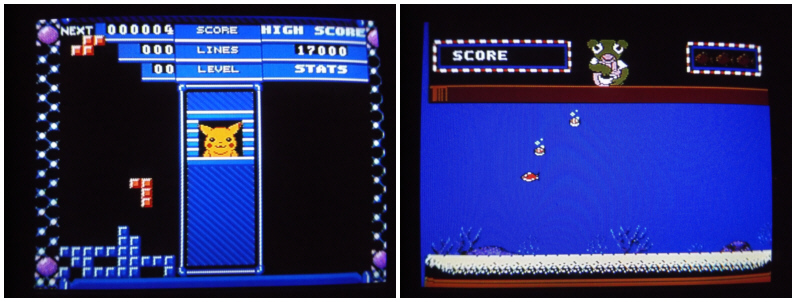
Pika Chu and Aquarium
092. Pika Chu - How about we begin with a healthy dose of copyright infringement? Pika Chu uses the mascot of the Pokemon franchise, the mouse-type pokemon Pikachu, to give this variation on Tetris its visual style. Interestingly this game shares more in common with the Tengen release of Tetris than either the official Nintendo release or the earlier Famicom version. Two players may play simultaneously and as with the Tengen NES game, there is also a mode to have two players play cooperatively in larger single well. The amount of game customization is surprising, with no less than four different block graphics to choose from and three different piece shape assortments, including the classic standard seven tetrads. There are even six different background music themes to select from and they all sound really good! If there is one shortcoming of this game it is that the control really isn't as solid as one would like it to be. Left and right tetrad manipulation feels very floaty and a bit too fast, making it easy to position a piece either to far or too short. Drop acceleration with Down on the directional pad works like every reasonable version of Tetris and is predictable and controlled. Blocks can only be rotated clockwise with the B Button, leaving the A Button to do nothing but halt all other control input when pressed. Possibly this is a programming error and the A Button was originally intended to do something but as it stands, this is pretty decent Tetris clone and is way better than the original Famicom version. Not bad at all and worth checking out.
098. Aquarium - This is much more the type of game I was expecting to find in this part of the list and a good introduction for what lies ahead. Aquarium feels more like a programming exercise than a game as it features little challenge. You control a fish in an aquarium while your completely insane bear owner drops what appear to be wedges of cheese, bananas, apples, rocks, and what I'm going to assume are fish food tablets into the tank. There doesn't seem to be any penalty for colliding with an object as everything but the rocks will simply disappear if touched with the fish's mouth and nothing impedes movement. If a food tablet reaches the bottom of the screen without being eaten then a fish is removed from the life meter in the upper right. Once the meter is empty the game ends, making Aquarium feel a bit like a strange mash up of Activision's Stampede and Kaboom! Eating food tablets are also the only way to accumulate points, five per tablet eaten. After reaching a score milestone the level is completed and the fish grows in size. This allows faster movement but the speed in which food settles in the tank is increased as well. The game seems to be inherently buggy as quite often I'll start a game and the bear will never begin dropping food, leaving the game as nothing but a fish swimming simulator and requiring a reset. This is the first and to date the only Famicom game I've actually fallen asleep playing. I'm assuming the no collision penalty problem is an issue with the version included on the multicart, as I can't see why the game would deliberately be designed to be so boring otherwise.
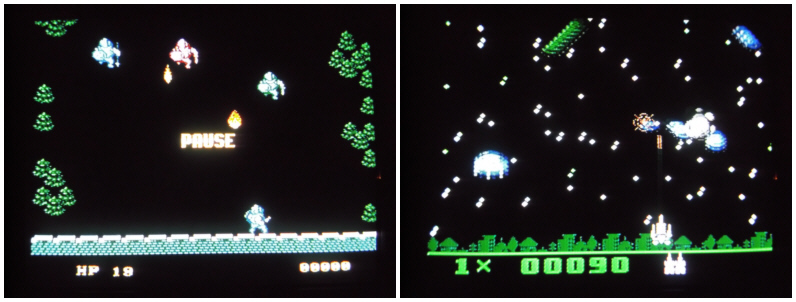
Arena and Air Alert
099. Arena - A wall defense style game with some very questionable design choices. In Arena the player controls a knight who can move back and forth along the bottom of the screen and must collide with invading soldiers who walk down from the top. Every time a soldier reaches the wall without being touched, a hit point is removed. Additionally balls of fire stream down from the top of the screen and touching one of those is met with instant death. The same short musical tune loops over and over, taking a break in between for seven seconds of sweet silence before blaring out once more. Terrible collision detection makes Arena a complete chore to play as the fireballs have enormous contact radiuses, well beyond what one would assume. Additionally it quickly becomes impossible to be able to reach the invading soldiers without being hit by a fireball as your knight simply moves far to slow to properly cover the bottom of the screen. The version included on the multicart also has text corruption in the between lives status screen.
100. Air Alert - A nice surprise, Air Alert is actually a clone of the Mattel classic Astrosmash / Astroblast from the previous generation of video game hardware. Rather than meteors raining down, your cannon now blasts away at chubby UFOs but they split apart and react just like the hunks of rock in Astrosmash. If a UFO passes the cannon and reaches the ground the only penalty is a reduction in score, while if a spinning bomb reaches the bottom of the screen it will destroy the player's cannon. The A Button fires, using the "one shot at a time on screen until it hits something" design of Galaxian. The B Button is an emergency warp that moves the cannon to a random location, either getting you out of a tight spot or into a worse one. Everything feels extremely similar to Astrosmash but the audible warnings when spinning bombs are approaching aren't as pronounced or as long lasting, instead relegated to a single beep. Also the screen color change to an eye bleeding blue at the 2000 point mark is massively distracting, only rivaled by the lavender color that shows up at 8000 points. Astrosmash fans should give this one a try as it's a pretty solid conversion of the game to the Famicom hardware and is extremely playable.
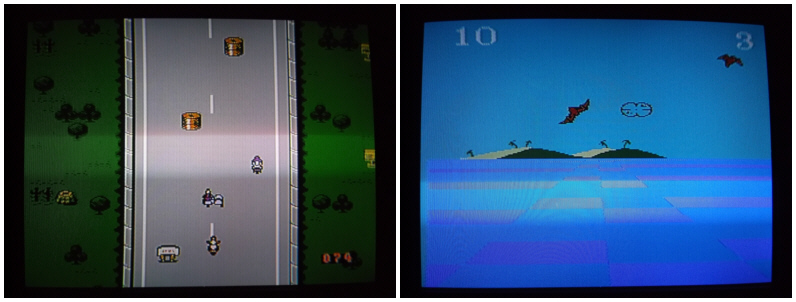
Awful Rushing and Aimless
101. Awful Rushing - Now that's not a title that inspires confidence. Unfortunately the name is a good representation of the game it leads. Awful Rushing is a motorcycle racing game that plays like Road Fighter without any finesse or an even more infuriating version of MotoRace USA. The directional pad is used to move the motorcycle left and right at the bottom of the screen while the A Button accelerates, with the throttle gradually easing off once the button is released. The same handful of objects and other riders come streaming down from the top of the screen and touching any of them will result in an explosion and lost time. All sprites are very small and relatively undetailed with no animation. The collision detection isn't terrible but you will definitely clip objects that you appear to be well clear of. These issues alone make the game boring and frustrating, however the terrible chiming march that constantly plays in the background culminates with the gameplay and design problems to make Awful Rushing give me an awful headache.
102. Aimless - Wow, these titles just keep getting better. Aimless is, well, a shooting game. A really, really, really terrible shooting game that plays like a light gun game that uses a control pad for input. The directional pad moves around a target reticule that looks like two bootleg Pac-Men smashed together while the A Button fires a pair of shots. Rather than the shots actively tracking with the reticule, they instead impact where the reticule was at the time the button was pressed. Sure, that's a little more realistic I suppose, but doesn't make for a very easy to control game. Your targets are teeny tiny little dragons that swoop around on the screen and breathe fireballs. If three of these fireballs impact the screen, then it's game over. However nearly every game begins with a fireball already hurdling toward the center of the screen and no matter how I try, there doesn't seem to be any way to deflect or neutralize it. Due to this, almost every game begins already down a damage point, with some games being over before they even begin. Shooting the dragons with any consistency is nearly impossible as they move way faster than your reticule or shots do, however you may get lucky and pick off a few here and there by chance. I can't think of why you would want to play this game anyway and the grating music seems to be there to drive away anyone who may want to give this one a "shot." An aimless game indeed!
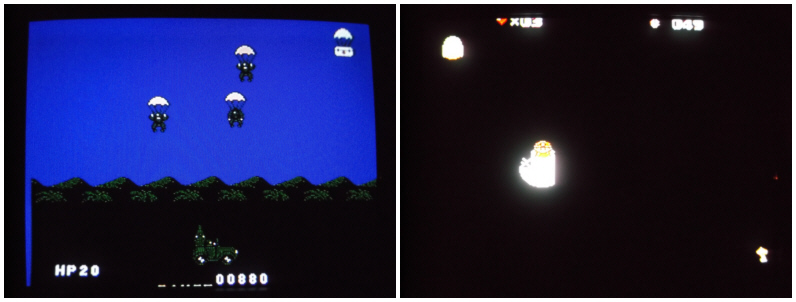
Burbles and Burrow Explorer
103. Burbles - The title screen music on this one sounds like part of Yankee Doodle - on crack. Burbles plays like Arena but instead of running into medieval soldiers, you're now driving around in a turret-equipped Jeep and shooting parachuting soldiers in camouflage. And, ah, you don't just shoot them and they disappear - they actually go limp as their parachutes continue to slowly carry their lifeless bodies to the ground. The directional pad moves the Jeep left and right at the bottom of the screen while the A Button is used to have the gunner fire his turret. Up to two shots can be on the screen at the same time and they move fast enough that it never seems like your cannon is hung up waiting to fire again. The B Button flips the Jeep in the opposite direction, allowing the gunner to be either on the left or right side. This only really comes in handy when you need to pick off a target on the edge of the screen but it can also get you out of a tight spot. If an enemy solider reaches the ground they will run off into the distance and your HP value will decrease. HP can be regained and increased by shooting medical kits that drift down on parachutes of their own. This game isn't bad at all and becomes extremely challenging when the speed of the descending soldiers increases, as the Jeep never gets any faster. There are only a few stages and with practice and a little luck, most players should be able to complete this one in a few minutes. I would say this was a passable little diversion of a game but there's just something unsettling about shooting paratroopers out of the sky, then watching their corpses drift to the ground. Suddenly I feel sorry for all those unarmed soldiers in Contra.
104. Burrow Explorer - Using assets from the NES conversion of Boulder Dash to create a more basic maze navigation game, Burrow Explorer doesn't have a lot on offer. Each stage is made up of a completely darkened maze, illuminated only by your explorer's headlamp. You must guide the explorer through the maze, avoiding the creatures that inhabit its depths, collecting treasure along the way, and walking to the exit before the timer runs out. Yes, creatures must be avoided rather than dealt with, which leads to simply following them around and waiting for them to get out of the way while attempting to avoid their deadly touch. It's like a pacifist version of Dig Dug with more realistic underground illumination and really terrible music.
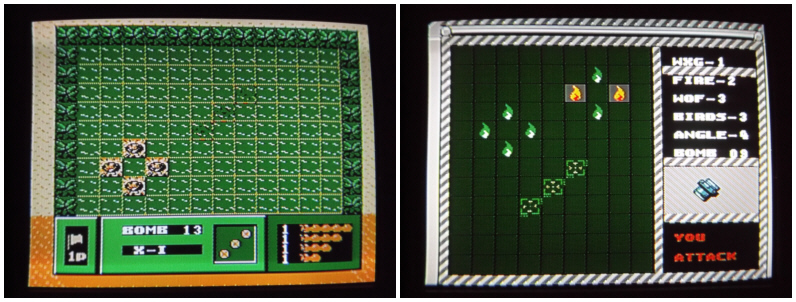
Bug's War and Bomb King
105. Bug's War - My first impression of Bug's War was, "Hey, this game has a pretty nice title screen," with a little animated spider swinging from a web spun beneath the letter U in the title. The game itself plays a bit like the classic strategy board game Battleship. Things begin when a group of bugs crawl out onto the garden playfield and take hidden residence. The player then selects the type of spread they would like to use with their bug bombs and where they want to deploy them. The capsules of pesticide are then dropped - striking hits or misses upon insects, just as one would use cannon shots to zero in on the enemy fleet during a game of Battleship. The wider spreads are useful for covering a larger area to acquire targets or for quickly dispatching a confirmed sighting. These deployments are limited however and most of the time you will be dropping single shots to deliver the final blow. The background music seems fine at first but is played in such a short loop it becomes irritating fairly quickly. Bug's War is decent but not all that inspired.
106. Bomb King - Not to be confused with Hudson's outstanding Bomberman spin-off Bomber King (released on the NES as RoboWarrior), Bomb King is - well, it's another Battleship clone! Except this time instead of naval warfare or garden extermination, you're attempting to blow up enemy troop barracks with air-to-ground explosives. Things function much the same as Bug's War, with special offensive spread patterns that can be selected in addition to standard bombing. At the start of each game you are allowed to position your barracks, again just like a game of Battleship, and then you and the computer take turns attempting to blow up the opposing force's field accommodations. The music is just as grating as Bug's War but at least with Bomb King there is a break in the audio loop when bombs are deployed. It even features a little cutscene showing the bombs falling. Thankfully the computer movements and attack sequences are very quick and omit the cutscene in favor of simply plotting out where their hits and misses are. I found this one reasonably enjoyable.
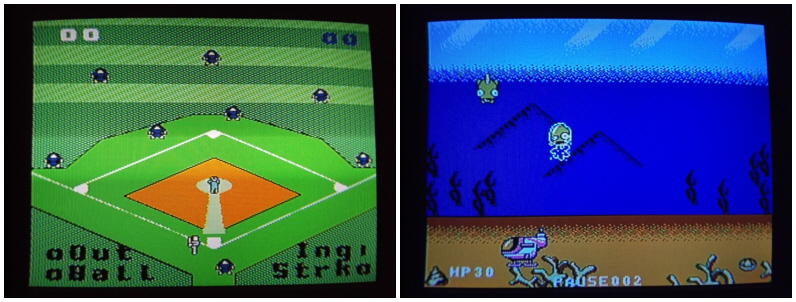
Baseball New and Bubble
107. Baseball New - Yet another Intellivision game remade for the Famicom, Baseball New is more or less Major League Baseball with graphics that are both slightly improved and degraded at the same time. As a Famicom conversion of the game, it plays well enough but there simply isn't a lot that can be said about this title, especially considering how much home video games had changed since the original release in 1980. Baseball New is lacking the sound effects that were such a big part of Major League Baseball however the game is now a single player affair with a computer opponent as the second player. More of a curiosity if anything for those familiar with the Intellivision game, I'd recommend everyone else skip this one.
108. Bubble - That title screen music sounds familiar, it sounds like Yankee Doodle - on crack. Wait a minute! Bubble is a clone of Burbles, or rather Burbles was a rework of Bubble. However rather than gun down defenseless paratroopers, you're now scrambling along the ocean floor in a submarine that looks like a helicopter. The tail section has a cannon which fires bubbles when the A Button is pressed and the whole thing flips around with a press of the B Button. The bubbles are fired at fish that descend from the surface above, becoming trapped in a bubble once hit. As this game and Burbles share the same program core everything else is the same. The medical kits in Bubble are strange lunch boxes or rations or something I'm not completely sure of, but function in the same way and restore HP, while a fish that reaches the bottom of the screen will drain HP away. Although I commented how surreal it was to be blasting away at defenseless paratroopers in Burbles, that shocking novelty actually makes it a more compelling game than Bubble, which seems overly generic in comparison even though they are the same game.
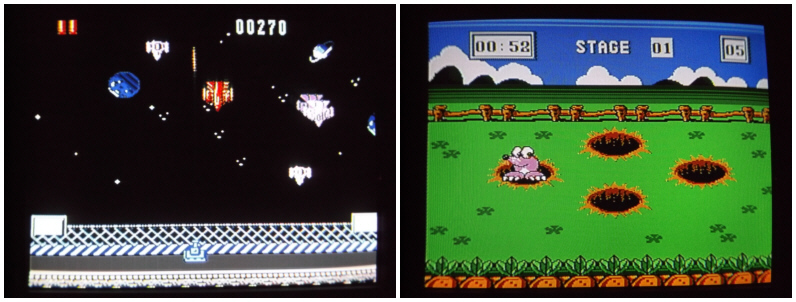
Cannonade and Hitmouse
109. Cannonade - No, it's not some new unlicensed sports drink, Cannonade is actually a rework of Air Alert, itself a conversion of the classic Intellivision game Astrosmash. This time you control a tank that must destroy a series of diving spaceships. Controls are identical to Air Alert with left and right movement, the ability to have a single shot on the screen at the time, and an emergency warp to get out of sticky situations. What is different is now the game uses a standardized scoring system, completely removing any penalty for standard enemies to reach the bottom of the screen. The enemy spacecraft also do not split apart the way the meteors in Air Alert do, meaning there are less objects to shoot in close proximity, which in turn slows down how quickly you are able to fire consecutive shots. Rather than spinning bombs Cannonade features blue diving spacecraft and bombs, which will explode the player's tank if they reach the bottom of the screen. These blend in a lot more than the spinning bombs of Air Alert, and as with that game the distinct warning sound featured in the original Astrosmash is missing here, making detecting them sometimes difficult. All these subtle changes result in a very slow and boring take on Astrosmash.
110. Hitmouse - A very basic Whack-A-Mole style game featuring what appear to be moles in the game itself but mice on the scoring screen, Hitmouse is the very representation of lazy game design. Only the four cardinal directions on the directional pad are used, corresponding to holes in the ground to the top, bottom, left and right. Two different colored "mice" and what appears to be a stalk of corn pop out of the holes and are struck by a small sprite of an animated mallet if the direction pressed matches where a varmint pops out. The game seems to go on continuously, even if a direction is never pressed, moving to the next stage of the same thing once the timer runs down. Perhaps this would be fun for very small children but for everyone else there is simply no challenge or strategy as only one enemy ever appears on screen at a time. The score totaling seems to be completely broken as rarely does it add up correctly. At first I thought there was some type of enemy class grouping that would add or remove points based upon going after the same color targets but that doesn't seem to be the case. This one isn't even worth a glance as the game doesn't seem to care if the player is even playing it, it just goes on and on without them.
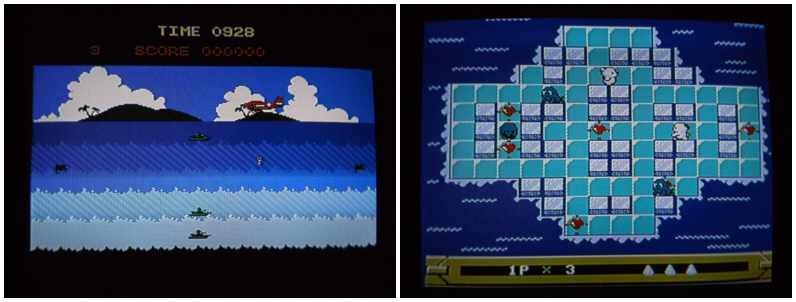
Coast Guard and Cub Adventure
111. Coast Guard - The reverse of many of the shooting games we've seen so far, Coast Guard has the player controlling the timing and position of bombs dropped from an airplane. The bomber automatically moves back and forth along the top of the screen, appearing from either side seemingly at random. Pressing either the B or A Button will drop a bomb toward the ocean below where enemy ships zip along in five distinct zones in the water. A pair of marker flags is moved up or down with the directional pad, and these tell the bomber which zone is to be targeted. A bomb dropped from the bomber will arc in the direction of the bomber's travel until it reaches the zone selected at the time of deployment. If an enemy ship is in the impact area it will be destroyed and points awarded. The catch is that the enemy ship must be in the same horizontal zone that the marker flags were when the bomb was deployed - there are no accidental contacts and this makes the game more of a chore than it should be. With how precise you have to be in deploying a bomb, coupled with the sheer randomness and unpredictability of the enemy ships (not to mention the bomber's direction of travel), Coast Guard tends to boil down to dumb luck. That's fine because it's a pretty dumb game.
112. Cub Adventure - Well at least the title doesn't sound as ridiculous as some of these. Cub Adventure has nice looking graphics reminiscent of the Sega arcade classic Pengo or the nearly forgotten NES puzzler Kickle Cubicle, however it is extremely lacking in the gameplay department. While the visuals are reasonably cute this is yet another game where you must completely avoid patrolling enemies while picking up all the objects on the screen. Pressing the A Button drops what appears to be a volcano, or dare I say it, a pile of bear excrement. It's always dropped on the square directly behind you so perhaps that really is what it's supposed to be. Then again the player character seems to be a snowman rather than a bear cub so who knows. These act as a temporary barrier that will divert enemies who may walk into them but your stock is limited. After collecting all the hearts on a stage a small rotor will appear, which when collected, will allow you to fly off to the next stage. While the ability to have some defensive impact upon the wandering enemies gives this game a bit of a strategic edge over titles like Burrow Explorer, it would be nice to have some offensive capabilities as well. The collision detection is also a little touchy, and seems to be based around the parameters of occupying the same square rather than coming into contact with an enemy, leading to some unfair deaths.
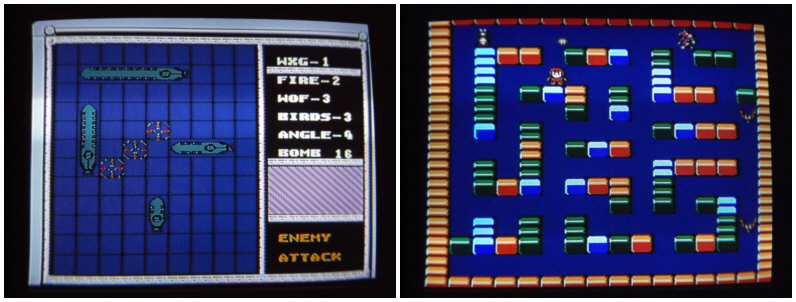
Depth Bomb and Devildom
Doom
113. Depth Bomb - A game we've seen before, Depth Bomb is the same game as Bomb King except it involves dropping depth charges at a fleet of enemy submarines rather than tossing bombs at enemy troop barracks. The sound effects, music, and gameplay are all identical to Bomb King, with the same types of special spread deployments. The only changes are that the graphics now represent undersea naval warfare rather than tents on a battlefield. The icons used to represent the different special deployments are still the same odd sprites that look more like satellites than explosives, but aside from that there seems to be a little more visual polish here. I especially like the circular "HIT" markers that are shown on the grid when a submarine is destroyed. I thought Bomb King was pretty fun and with the sight visual differences on offer here, I find Depth Bomb slightly more appealing. I suppose this type of game really just works best with naval vessels.
114. Devildom Doom - With a hilariously ominous title that sounds like something an eight-year-old would dream up if given the chance to develop an action figure line, Devildom Doom is yet another maze game that looks a little like Bomberman. And what do you know, this is a maze game that actually gives you an offensive weapon! Although it has to be picked up from a random location in the maze and only awards six shots, compared to most of these Nice Code maze games, it'll make you feel like John Rambo. A spider, a knight, and a pair of bats wander the maze, firing from time to time, and will reappear from distinct spawning points once destroyed. The problem is the game never seems to change any at all. The enemies constantly reappear, the player seems to have infinite lives, and I can't seem to figure out any objective to the game other than wasting time doing the exact same thing over and over for points. This is apparently a rework of a Famicom hardware conversion of the Intellivision game Night Stalker but I remember that game having a lot more action.
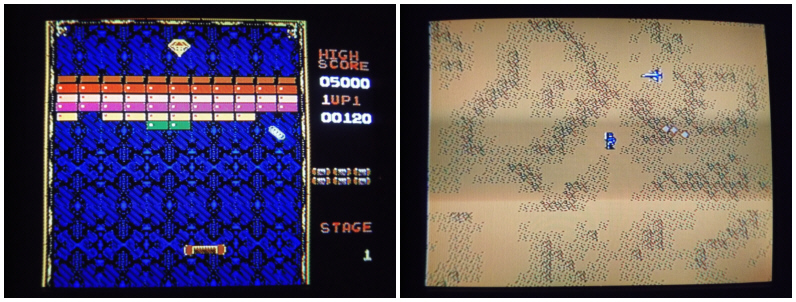
Diamond and Dune War
115. Diamond - A clone of Arkanoid using original assets, Diamond is a reasonably professional take on the Famicom version of Taito's pall-and-paddle arcade classic. The board layouts are mostly mirrored from those of Arkanoid but rather than destroying all the blocks as the objective, Diamond is all about collecting large diamonds tucked away in plain sight on each playfield. Additionally the powerup capsules of Arkanoid are now smaller diamonds that grant many of the same powers. The color pallet, emphasis on gems rather than capsules, and even the background music remind me of Sega's Columns in terms of presentation. The game itself plays okay but the paddle moves pretty slowly with no way to speed it up. Additionally the ball can pick up speed on a deflection without warning, and then slow down on the next ricochet, seemingly at random. The ball also behaves rather oddly, generally chewing through blocks in horizontal zigzags, but this is not entirely predictable. I suppose that's the big shortcoming of Diamond, how the basic ball physics cannot be reasonably predicted. Arkanoid succeeds as a great game and is still fun to play because of how tightly refined the controls and physics are, while Diamond is lacking in those two aspects. Item collecting as the objective in a ball-and-paddle game isn't anything new, with Atari's Off The Wall being my favorite game in the genre, but it's nice to see these companies try something a little different with a proven formula.
116. Dune War - As the game starts off with a silent title screen, I can't help pondering that maybe we'll be spared from horrible endlessly looping music for a change. The title screen for Dune War also features a strange digitized photograph of a soldier holding some kind of bazooka that I can't make heads or tails of, as something about it just doesn't look right. Of course, it's a perfect representation of the game it fronts because something about the game itself isn't quite right. A small blue solder at the center of the screen is whom the player controls. Left on the directional pad rotates him clockwise while Right on the control pad rotates him counterclockwise, which feels strange and reversed. The A Button fires rapid shots from the soldier's cannon and can be held down to fire endlessly. There's actually a nice effect of the shots growing in size as they move away toward the edge of the screen. The B Button on the other hand, well, I believe "accelerates" would be the most correct term. That's exactly what it feels like, depressing an accelerator in a motor vehicle as it causes the soldier to run in the direction he is facing. He can actually get going pretty fast and rotating him while he is running creates a strange drifting situation that feels more like something out of a street racing game. The objective is to shoot down slowly patrolling aircraft but due to the odd controls this is easier said than done. It's a little like playing Smash TV on ice, although this game takes place on sand. The playfield scrolls in every direction but is little more than the same pattern of endless sand, and although it can get a little jerky on occasion during a direction change, the scrolling isn't half bad. It's still really boring but at least it isn't completely broken. Apparently this is a rework of Nice Code's conversion of the Intellivision game Space Hawk, which would make a lot more sense. I will say Dune War is the only game I've seen to feature a heavily armed soldier who can moonwalk through an endless desert with the greatest of ease.
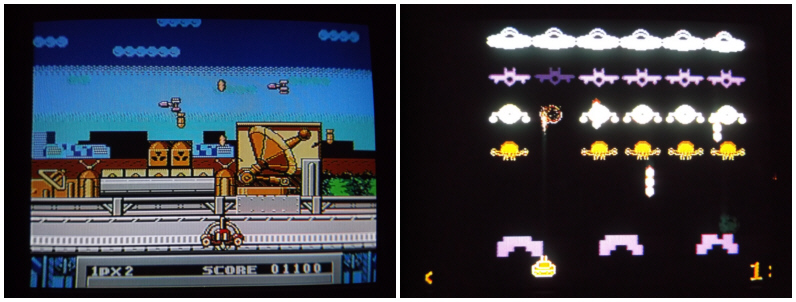
Firebase and First Defender
117. Firebase - Yet another ground-based cannon shooter, Firebase mixes things up a little by having the targets scroll overhead from the right side of the screen to the left. The graphics aren't bad and the background looks like something out of a Mega Man game except a little less detailed. The player's cannon has a little rotating animation as it is moved back and forth and the colors are vibrant and pleasing. The sound in this game is quite odd as the background music halts when an enemy ship is destroyed. Most of the time the full explosion sound effect won't play either, as if the two sounds are colliding with one another. The music will remain missing until the player fires another shot or waits for a few seconds until the music starts over again. I'd assume the sound is getting stuck and the call being made for the sound of the player's cannon gets it going again. If you're blasting away constantly you won't notice this but the explosion sound effects will still be stepped on pretty frequently. All the same, Firebase is extremely repetitive and lacks any sort of challenge.
118. First Defender - Well First Defender has a snappy little theme song, something that can't be said of many of these Nice Code games. However the game itself is a really glitchy rework of their conversion of the Intellivision game Space Armada, itself a clone of Taito's Space Invaders. Honestly First Defender is pretty terrible, with the entire screen scrolling along with the invaders, including the number of player cannons in reserve as well as the defensive shields. The invaders look terrible, even worse than the non-copyright-infringing invaders of the Intellivision original, and have absolutely no animation. The audio is also horrendous and extremely generic and minimal. I have no idea why it was so difficult to make a solid Space Invaders clone for the Famicom but First Defender is even worse than Taito's lackluster official Famicom release. The only thing this game has going for it is that catchy title screen song.
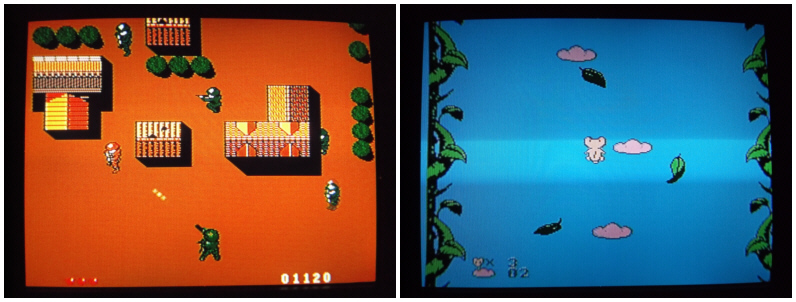
Five Days and Frantic
Mouse
119. Five Days - Another war-themed title, Five Days is as poorly conceived as it is titled. The player controls a soldier manning a mounted gun at the bottom of the screen. He cannot move, only rotate the gun in one of five distinct directions. While one would assume a mounted gun like this would be able to lay down a lot of firepower, that's not the case as it can only fire one shot on the screen at a time. Enemy troops slowly approach the soldier, eventually firing upon him and they must be shot before getting close enough to fire themselves. I'm sure by now it's easily apparent what the problem with Five Days is, namely its restrictive moment. Being able to only fire in five specific directions from a fixed-point means that enemies can only be dealt with when they are in those five specific regions. Additionally in the first stage the right side of the screen provides nearly complete cover for enemies, as the diagonal shot to that side is blocked by terrain. If a group of two or three enemies comes down that right side slot, you can be sure that at least one of them will get a shot off before they can be dispatched, they simply cannot be taken care of fast enough. Thankfully there is some variety in different stage backgrounds but the right diagonal shot is still gimped with limited distance, as if it's still being blocked by terrain. Green enemies go down in one hit while blue enemies require two, turning green after the first hit. A bonus item will be dropped when defeating a red enemy, which must be shot to be collected. One of these increases the firing and movement speed, making the game respond at the pace it should have played at from the start. Ultimately each play of this game boils down to a half a dozen enemies slowly gathering around your soldier as he desperately mans his peashooter of a turret, eventually being taken down at point blank range.
120. Frantic Mouse - One of the most basic platforming games one could imagine, Frantic Mouse tasks the player with guiding a small white mouse vertically up a seemingly endless chain of fluffy clouds, flanked with beanstalks on either side. There are no directional controls, and only the A Button is used, causing the mouse to jump straight up. While some challenge and spice could be added to a concept such as this, you won't find any of that here. The entire game is literally waiting for the cloud above the mouse to line up with him, pressing the A Button to jump up to the cloud above, catching the next cloud at the peak of his jump, and then doing it again. The clouds move in different directions but never does it become even the slightest bit tricky, only irritating. I do suppose that Nice Code was ahead of their time as Frantic Mouse feels like a cheap smartphone game from the early days of that genre.
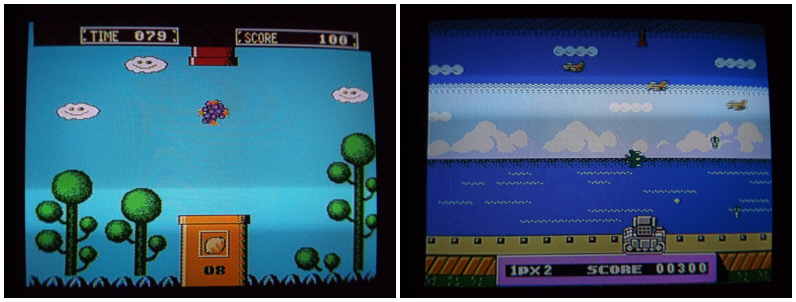
Fruit Dish and Gallagant
121. Fruit Dish - I really shouldn't be getting too frustrated at how simple most of these Nice Code games are, after all, they were mostly created to fill out Famicom clone hardware packages and multicarts. At least some of the titles are hilariously descriptive of how worthless the games are. Fruit Dish, however, should have been called "Fruit Pipe." The game itself is the most basic single-button sorting game one could possibly imagine. One of five different types of fruit fall from a pipe at the top of the screen, one at a time, into a pipe at the bottom of the screen. A crosshair surrounds the fruit as it falls but there is no directional input in Fruit Dish. Pressing the A Button will cycle the falling fruit through the five different types, with the objective to match it to the fruit shown on the pipe below. Each stage has a quota to meet with the only penalty for an incorrect fruit being lost time. This is how the entire game plays out, with nothing more than tapping the A Button a few times every few seconds. Eventually the game does mix things up a little with more than one set of pipes, requiring a little more thought. However the crosshair still automatically locks onto the fruit and the gameplay never moves beyond tapping the A Button to cycle through the fruit assortment.
122. Gallagant - I was hoping this one would be a Galaga clone or something but unfortunately Gallagant is a clone of Firebase, or rather Firebase was a rework of Gallagant. As with Firebase, the background music halts when an enemy ship is destroyed and requires another sound to be played to get it going again, otherwise picking up at the next start of the loop. The background isn't as interesting as in Firebase with a plain simple oceanfront backdrop. The enemies however have far more varied attack and shot patterns that have wide coverage and will make short work of your slow-moving tank. Many enemy aircraft actually reach the bottom of the screen and will collide with your tank once reaching the end of their paths. While Firebase was a terrible game due to how slow and boring it was, Gallagant is a terrible game for the exact opposite reason. There's simply too much going on here and your sluggish movement and large footprint simply cannot keep up. To evade enemy fire you have to plan and execute your movement the moment an enemy shot first appears on screen, otherwise you will be too slow to get out of the way. With time the shot patterns can be learned and it's nice that there's actually some variety with different enemies, who use different attack patterns, appearing on subsequent levels but Gallagant simply isn't entertaining enough to hold my attention.
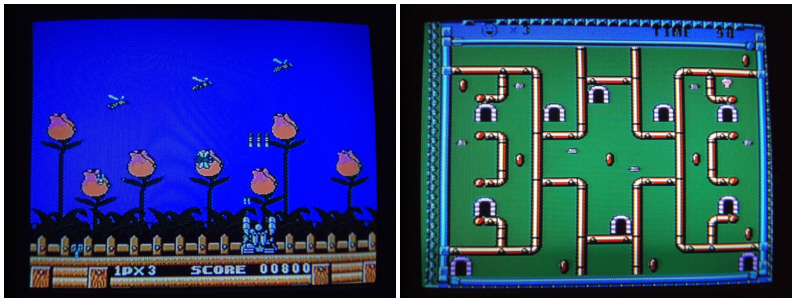
Garden War and Gate
123. Garden War - Oh no, it's the same title screen music as Firebase and Gallagant. Yes, Garden War is yet another game built off reworking Gallagant, with the same sound issues that the core game had. However this time instead of shooting at spaceships or aircraft you're shooting at flying insects. And rather than a cannon or a tank, you control a heavily armed robot that looks like Blaster Keaton in Aero Fighters 3. Shots the robot fires have a wider three missile grouping than the shots in the other games but it really doesn't make much of a difference, the game is still a bore. Although Garden War feels as if it is in between Gallagant and the stripped down Firebase, I actually find it less enjoyable than Firebase due to the ugly graphics. That said all three of these games, built from the same parts, aren't very good at all.
124. Gate - Opening with a silent title screen, Gate finally delivers what I've been hoping for: a Nice Code game with no background music. This is another maze game where hearts must be collected, similar to Cub Adventure, however this time the player is controlling what appears to be a worm. The game's title comes from the main method of transport throughout the maze, that of a number of warp gates that move your worm from one location to another. The only real issue with this is that until you play the game a bit and memorize the warp drop off points, there's no way to predict where a gate will warp you to. The very small and quite undetailed graphics don't help this any, and most of the time you'll be frantically looking around the screen, trying to figure out where you've been moved to. More often than not a gate will warp you directly into a patrolling enemy, resulting in instant death. Most puzzle and maze games that use a warping mechanic like this, warp you from one clearly marked area to another clearly marked area, alleviating this problem and allowing time to plan movement strategy. Without this design consideration Gate becomes frustrating after about ten seconds and I can't even recommend giving this one a try.
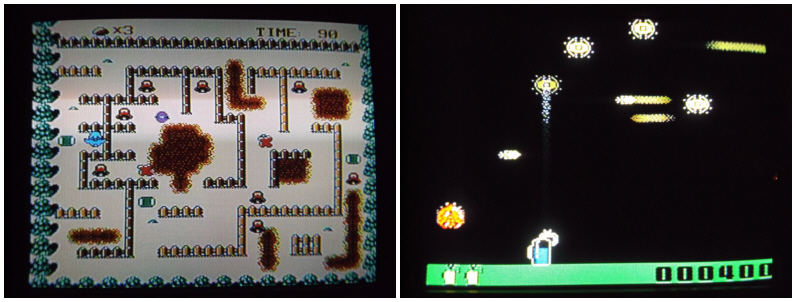
Hallihoo and Hexapod
New
125. Hallihoo - Very similar to Gate except with larger sprites, annoying background music and no warping mechanic, Hallihoo is yet another maze game about collecting objects. This time you appear to be a bluebird that must collect bells to open a staircase down to the next level. Although everything is far more detailed with cleaner sprites than most of these maze games we've seen so far, the enemies are still relatively nondescript, made up of odd shapes and blobs. Thankfully the different enemy types have different behaviors, with one of them being fairly unpredictable as it rolls around wall edges. Unfortunately the bluebird doesn't have any offensive or defensive measures. What it does have is a hilarious death animation of exploding into a ball of fire that dissipates into a ring of flame, like something you'd see in Contra or LifeForce. While Hallihoo is more playable than most of these types of games we've seen in the Nice Code assortment, that isn't saying much.
126. Hexapod New - A rework of Nice Code's Famicom hardware conversion of the Intellivision title Buzz Bombers, Hexapod New opens with a pleasing title theme and a large version of its primary enemy sprite zipping across the screen. Amazingly this game actually even has a really nicely designed logo. The game itself plays exactly like Buzz Bombers with ground-based insects scurrying around rather than bees in the original game. The visuals are plain but clean and the entire game runs at a quick and stable clip. As with Buzz Bombers the player controls a can of insecticide complete with an anthropomorphic hand to depress its own spray nozzle. Hexapod New actually plays quite a bit faster than Buzz Bombers did, making for a fun and frantic simple score-based shooter. If an insect reaches the bottom of the screen it will cause flowers to grow, making the movement area smaller. If the spray can is trapped completely then a life is lost and the level starts over. Additionally every shot drains the spray can and once a can is empty, a reserve life will be put into play. Although it's missing the rendition of "Flight of the Bumblebee" that the original Intellivision game featured, Hexapod New is a great rework of the classic title for the Famicom hardware. The increased speed really does give this game some new life and is very enjoyable to play.
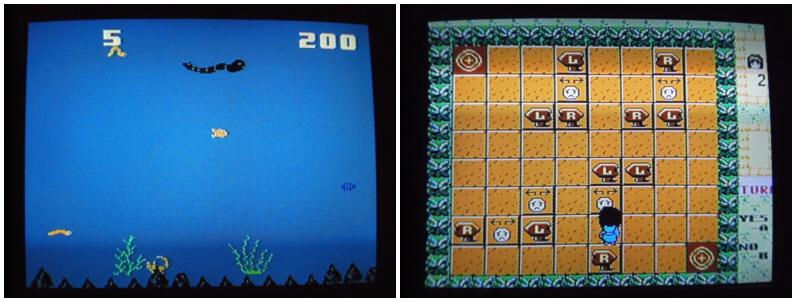
Hexapod War and Labyrinth
127. Hexapod War - Speaking of Intellivision reworks, Hexapod War is a rework of Nice Code's conversion of Shark! Shark! Rather than taking place underwater the player now controls an insect that must eat other insects and avoid larger predators. Except the game still feels as if it's taking place under water, complete with swaying sea greens at the bottom of the screen. Ill-conceived doesn't even begin to explain it but heck, they must have been proud of their Intellivision conversion and wanted to slap it onto as many other multigame projects as they could without the license. I actually think Shark! Shark! Plays quite a bit faster and better than this rework does, making Hexapod War a curiosity at best.
128. Labyrinth - Reminding me a tiny bit of the Kero Kero Keroppi game also featured on this multicart, Labyrinth is a puzzle planning game with an interesting interface. Notice I said "interesting" and not "good" or "intuitive." A little girl automatically walks through a playfield divided into a grid, turning either to her left or right when she encounters a signpost marked L or R. Occasionally she will step on a square with a sad face and both left and right arrows. In this moment a three second timer begins and the player can choose whether or not to "turn" by pressing A or B. The Yes or No option seems to set if the girl will follow the direction on the next signboard she encounters or go the opposite direction. As the time limit at each stop is so short, again only three seconds, very little planning can be done. The ultimate goal is to guide the little girl to the exit square. However with the short time limit and the less-than-intuitive direction control setting, it often seems as if the girl is wandering around aimlessly and ignoring the inputted commands. I suppose it doesn't matter either way, as there is so little to this game it's simply not worth the effort in wrapping your head around its odd input scheme.
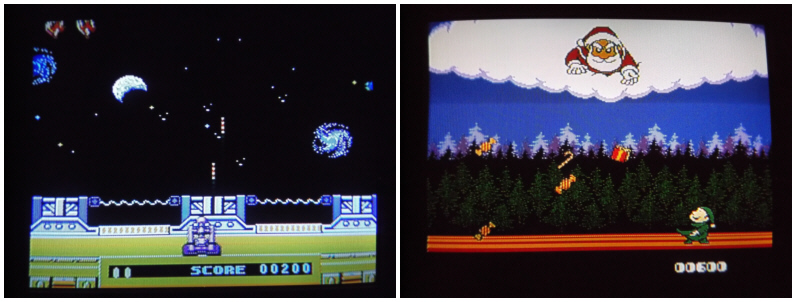
Lunarian and Mad Xmas
129. Lunarian - Ah, yet another Gallagant rework, Lunarian does add something a little different over the three similar games we've seen so far. That difference is a pair of defensive energy shields activated by pressing the B Button. These are located just to the left and right of the center of the screen and don't deflect enemy shots, however they will destroy any diving enemy spacecraft that come into contact with them. Rather than the military theme of Gallagant or insect and robot motif of Garden War, Lunarian is more akin to Firebase in that it has a sci-fi backdrop, this time apparently taking place on the moon. Thankfully the cannon here can fire up to two shots consecutively like in Firebase but unlike Firebase there's actually a lot more to shoot here. Although it suffers from the same halting of the background music, the explosion sounds in Lunarian don't get drowned out as much, better covering up the background music issue in hand with the more rapid firing sound. The challenge here feels more balanced and frantic than the other games since there's always something going on and you are granted both the offensive and defensive capabilities to handle it. Due to this, Lunarian is my favorite of the four games we've seen so far that are built upon the same core. This one is actually fun in an old school early 1980's home console shooter kind of way but the music is still horrendous.
130. Mad Xmas - A Mad Xmas is what you'd have if this were the game you unwrapped on Christmas Morning. Well, unless you're me because I love these crazy pirate cartridges. This is a very slow and strange game in the vein of Activision's Kaboom! A rather pissed off looking Santa Claus rains down candy, wrapped presents, and candy canes from his cloud overhead, which the player must collect in the role of an elf. Santa also throws hazards, which must be avoided including devil faces, lighting bolts, and bombs. Devil faces will slow the elf's movement temporarily while lighting bolts will shock him and cost a life. Bombs will blow the elf up, leaving him as a chattering skeleton, taking a life in the process. Mixed in with the items are pairs of roller skates, which when collected will increase the elf's movement speed. There is no penalty for missing an object and the only real challenge of the game is in avoiding the harmful items. The collision detection for collecting isn't that great as falling objects must be lined up perfectly with the elf's tray for them to count. The hazards on the other hand will hurt the elf regardless of where he may come into contact with them. Outside of the boring gameplay and grating music, the biggest failing with Mad Xmas is that objects can often be stacked on top of one another and due to poor sprite priority handling. This means you can be hit by a hazard hidden behind another object and this happens far more frequently than it has any right to.
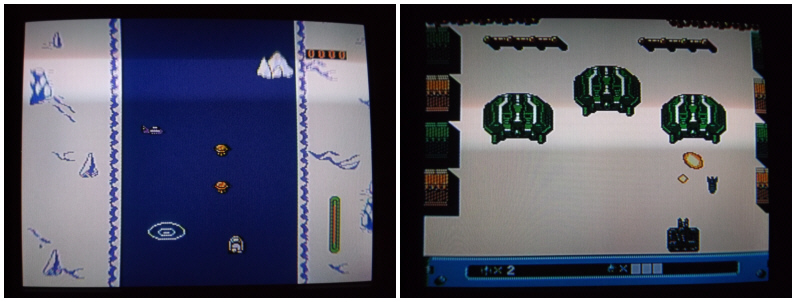
Motobot and Panzer Attack
131. Motoboat - Awful Rushing on a river rather than a roadway, Motoboat is actually a little more playable than the previously covered game. To begin with there's actually an objective beyond not hitting anything, in the form of collectibles that can be picked up for points. However picking up an item causes the beat line of the background music to drop away temporarily. Additionally there's a fuel meter that slowly runs down, giving the game a sense of urgency. Problem is Motoboat doesn't need anything to further its sense of urgency because the scrolling zips along at a breakneck pace. Most of the hazards that must be avoided are airplanes that move back and forth across the screen and they can be very hard to maneuver around with how fast the boat travels. Generally once you see a possible collision on the horizon it's too late to react and avoid it. This really is one of those "blink and you tie" type of scrolling games. Amazingly it's still way more enjoyable than Awful Rushing as there's a lot less stuff to run into, meaning you can get a decent rhythm going on occasion. That doesn't mean this is a good game by any stretch but at least you can play it for a bit without wanting to tear your hair out.
132. Panzer Attack - Another shooting game with a tank at the bottom of the screen that fires upward, Panzer Attack plays like a series of boss fights from a really early war game. Bombs fall from the top of the screen but they're really only interference for the primary objective, a series of fixed turrets that fire downward. The turrets fire very large, however very slow, energy blasts that must be avoided in between returning fire. Your tank can only have one shot on the screen at a time, leading to a slow back-and-forth firing exchange when only one enemy turret remains. Interestingly Panzer Attack is a very quiet game, with the short background tune usually dropping out completely and features only the slightest sounds from the tank's cannon and shot impacts upon the turrets. Yet the most striking thing about Panzer Attack is how short the game is, having only two levels and then displaying "WIN" on a black screen before returning to the title. Seven turrets, that's it, seven targets in the whole game! I suppose I can't fault Panzer Attack all that much, at least it's over before it becomes annoying.
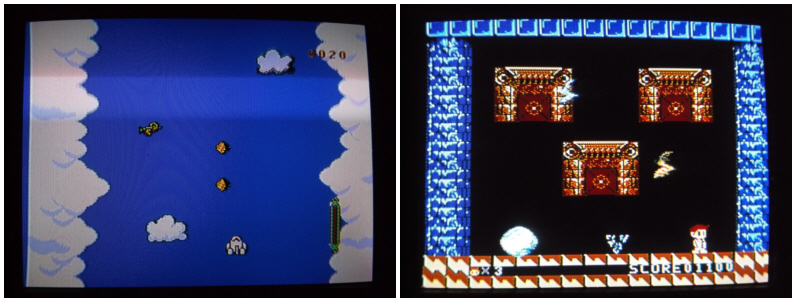
Pobble and Polar Bat
133. Pobble - Apparently Pobble is the game that Awful Rushing and Motoboat were spawned from. Rather than taking place on roads or rivers, Pobble moves the action into the air with the player controlling an airplane. There are point collectibles and a fuel meter as were carried over into Motoboat but movement doesn't feel as quick or as smooth as in that version of the game. If you ever wanted to play a video game where an airplane explodes if it hits a cloud, well then this is the title you've been looking for. That would be like the Vic Viper exploding if it touched an option pod in Gradius - and speaking of Gradius and the Vic Viper, Pobble basically has Konami's famous ship on its title screen. Truth be told it's only the darker storm clouds that have to be avoided but since the game scrolls so fast it can be nearly impossible to consistently tell them apart when moving at full speed. In my opinion Motoboat is a more playable version of this game as in that rework the safe and deadly obstacles were made into easy to differentiate objects, namely whirlpools and icebergs.
134. Polar Bat - The title screen for Polar Bat features a slightly amateurish redraw of Kunio-kun, taken from the "punching" splash screen Technos used at the beginning of some of their Famicom games. So what is this going to be, a Renegade or River City Ransom clone? Well not really, this is yet another shooter and apparently uses the same engine as Panzer Attack except rather than a tank you control a small boy. In addition to shooting upward at bats with the A Button, he can also jump with the B Button. This is necessary as snowballs will appear on screen and roll to the left or right once reaching the ground. The jumping mechanics feel very poor and rushed, as while the jump direction is fully controllable in mid air, the boy jumps in a very tight and sharp apex. This isn't too bad when there's only a single snowball but as they begin to double up things become extremely tricky. This is made even more difficult when icicles are falling from the ceiling, often creating squeeze plays that can simply not be worked out of effectively. At least the title "Polar Bat" makes sense as the game involves shooting bats in an ice cave, as little sense as that may make otherwise.
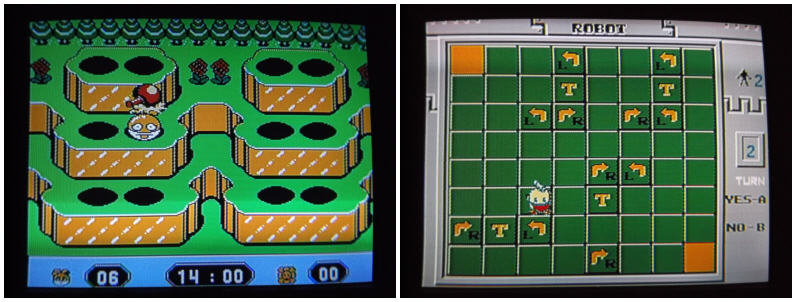
Ruralgoblin and Robot
135. Ruralgoblin - With a title like I would expect some kind of monster game but no. Ruralgoblin is another Whack-A-Mole style game, even more basic than Hitmouse. While the game itself is nicer than Hitmouse in terms of presentation and graphic detail, gameplay is even simpler. Enemies pop up from one of twelve holes and must be bonked on the head with a mallet. However rather than requiring a direction to be pressed, the only input in Ruralgoblin is the A Button. If you see an enemy anywhere on the screen, press the A Button and they are dispatched automatically. That's it - that is the entire game. Tapping the A Button throughout an entire stage will award maximum points every time. At least the end of stage score totaling seems to work correctly with Ruralgoblin, which is important, as achieving a clear score is how each stage is completed. Or as the game refers to it, completing a mission. An odd title all around, there's nothing here to hold the interest of anyone other than a very young child.
136. Robot - The exact same game as Labyrinth except with different visuals, I find Robot a slightly more appealing game. For one thing the visuals are a lot clearer than they were in Labyrinth, which makes the game easier on the eyes. Rather than guiding a little girl around, this time you are directing a clockwork robot. The robot itself has some personality, with a key atop his head that rotates with each step he takes. Aside from that this is the same slightly irritating game of puzzle planning that Labyrinth was. While I find it a tiny shred more engaging, I still can't recommend it as anything more than a quick curiosity.
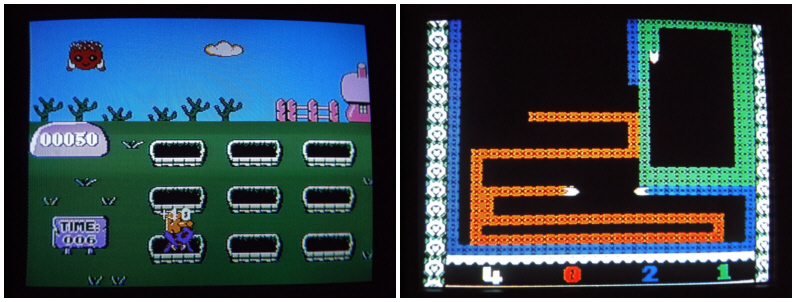
Season Garden and Shrew
Mouse
137. Season Garden - I'm starting to think that Nice Code's favorite genres are ground based single screen vertical cannon shooters and Whack-A-Mole games. Season Garden is the later, another Whack-A-Mole title but this time it's Whack-A-Mole with a difference! In Season Garden you actually have to move the hammer around to the specific hole where a pest is popping out, then press the A Button to smash them down. There are nine holes arranged in a 3x3 grid, mirroring the classic Whack-A-Mole layout. Additionally the graphic presentation is very nice, with seasons that change along with each level. The sun in the sky even dresses appropriately for each season, and there are a few really nice visual touches such as falling leaves during the autumn stages and snowflakes in the winter. The musical accompaniment is short but pleasant, and the sound effects are crisp and enjoyable. Interestingly the sound that plays when smashing a pest sounds like the pause sound effect from Square's Rad Racer. In addition to pests to smash there are also crystals to collect for bonus points and friendly creatures that are to be left alone, incurring a point penalty if they are hit. Meeting the point quota to continue to the next level is actually challenging and fun, a huge change from the other Nice Code Whack-A-Mole titles. I like this one and it shows that with the proper approach and attention, Nice Code could make solid little games. Season Garden is cute, well designed, and simply fun to play.
138. Shrew Mouse - One of the few Nice Code games I've seen open with an options screen, Shrew Mouse is a rework of a conversion of the Intellivision game Snafu. Shrew Mouse is a variation on a multiplayer snake type game, a genre that was popular in the late 1970's to early 1980's, and is probably best known to most as the basis for the light cycle sequence in the 1982 film TRON. Shrew Mouse pits the player against two computer controlled snakes, with eight gameplay variations that do things like allow diagonal movement, have walls of defeated opponents disappear or remain, and add objects to the arena that must be worked around. The amount of total rounds played in a game can be selected as well. I would have enjoyed a two-player option for this one but the computer opponents are fine, although they can become a little predictable after awhile. Control is everything in a game like this and the directional input in Shrew Mouse is quick and accurate. Not a bad little game at all.
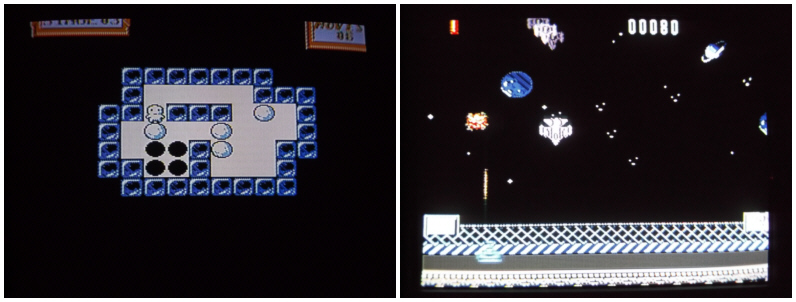
Snowball and Star Fighter
139. Snowball - On occasion Nice Code shows that they can compose competent musical themes. Snowball opens with a pleasant rendition of Frere Jacques, with a nice little marching beat, and a smiling snowman on its title screen. However as nice as their rendition of the French tune may be, it plays without end and will grate on your nerves after a few minutes. Snowball is a clone of Sokoban, the famous box pushing puzzle game in which you control a warehouse keeper who can push, but not pull, crates around a warehouse to put them in their proper locations. As one would expect from the title, in Snowball you are tasked with pushing snowballs into holes and rather than a warehouse keeper, you control a snowman. Now Sokoban games have been done to death so there's nothing new or incredible here but this game does contain some additional features that more barebones Sokoban clones sometimes lack. Pressing the A Button will undo the previous move but this is specifically limited to the most recent action. The B Button will bring up a menu that allows you to exit the game, restart the current stage, or cancel the menu. The problem with the menu is that "EXIT" is the first highlighted option, making it extremely easy to bail out of the entire game back to the title screen by mistake. It doesn't help that "EXIT" can also be interpreted as "exit the menu," leading to the same game-ending result. The ultimate failing with Snowball is how unresponsive the directional controls are, leading to input mistakes that cannot be undone with the A Button due to the game tending to read a double input.
140. Star Fighter - While we have seen some Nice Code games that share similar assets or are reworks of other Nice Code titles with slight visual and gameplay changes, Star Fighter features none of that. This is a straight up duplicate of Cannonade, except with a different title screen. Cannonade was a rework of Nice Code's Astrosmash conversion, and an extremely boring re-skin at that, making Star Fighter the exact same ho-hum experience. A completely unnecessary addition to the cartridge but it should go to show just how much mileage that Nice Code tried to get out of the games they developed.
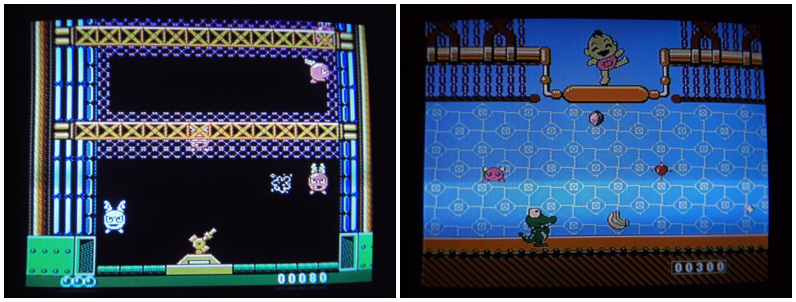
Strafe and Small Dinosaur
141. Strafe - A rework of Five Days, Strafe is far more visually appealing than the slow and drawn out shooting game we've seen before. Rather than control a solider manning a stationery cannon, you now control a whimsical bubble cannon that looks like something out of a Puzzle Bobble rip-off. The enemies are, well, I have no idea what they're supposed to be to be very honest. They look like fighterflies from Mario Bros. only really big and ugly. The background graphics, while quite colorful, look as if they were taken from another aborted game and resemble the "space scaffolding" seen in games like Star Soldier. All my gripes with Five Days can be carried over to Strafe, including the odd shot limiting behavior to diagonal right. It's even more irritating here as there aren't any visible obstructions that should be halting your shots. That's just bad, or rather quick and dirty, programming 101 I do suppose. There is certainly nothing redeeming here, and Five Days was pretty terrible, so I recommend skipping this one completely.
142. Small Dinosaur - A rework of the Kaboom! themed Mad Xmas, Small Dinosaur has an even stranger premise than an elf gathering candy and gifts from Santa Claus. This time you control a dinosaur, which looks like an alligator, at the bottom of the screen that must collect items that rain out from, are you ready for this, a dancing baby. As a dinosaur doesn't wear any clothes you now eat the objects that award points, including hearts, gems, and what appear to be little smiling bugs. Eating bananas will grant a speed increase while touching what appears to be a water balloon full of grape soda will slow you down. The lightning bolt from Mad Xmas returns and will electrocute the dinosaur if touched, costing him a life. Additionally there is a rather large falling bolt that will injure the dinosaur, taking a life as well. Mad Xmas was a pretty strange game and this is a really odd rework of that concept, but by far the strangest thing I find in Small Dinosaur is how limited the dinosaur's walk animation is. It appears to be three frames that animate at about a thousand miles per hour. Really the walking and eye movement of this animation would be pretty decent if it were slowed down to the appropriate rate. All the gameplay problems of Mad Xmas are here including a boring game with little challenge, items that tend to overlap one another and unnecessarily cost lives, and very rough collision detection.
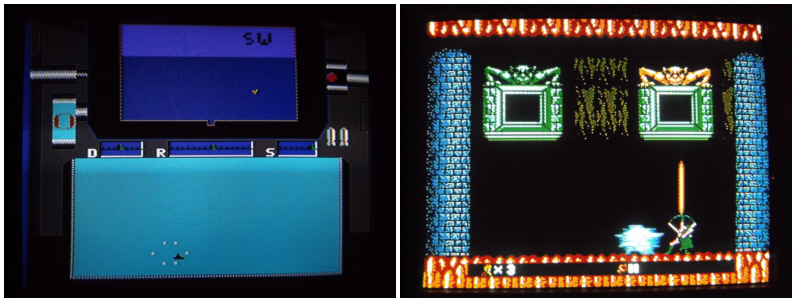
Silent Hunter and The
Archer
143. Silent Hunter - Another of Nice Code's Intellivision conversions reworked for release without the Mattel branding, Silent Hunter is based on the Famicom hardware conversion of Sub Hunt. Now this is an Intellivision game I'm not super familiar with so I'll have to judge this title on its own Nice Code merits. While the visual presentation is somewhat plain, understandably as it is based off an Intellivision game, it does at least make good use of colors to present the action in an easy to understand fashion. The Select Button cycles through your submarines and the directional pad moves them. Once a submarine comes into contact with the enemy fleet, the gameplay changes to that of closer sonar. Left and Right on the directional pad steer the sub, while Down will cause it to dive. Speed is selected by pressing the B Button, cycling through three settings. The objective here is to get your sub near the white blips on the sonar screen, representing the enemy fleet, and then destroy them with torpedoes by firing with the A Button. While the game plays fine there really isn't a lot of action to be had here, which is understandable considering the game's vintage. Decent all around but not one I would pick up and play again.
144. The Archer - We've actually seen two games previously that used The Archer as their base and those games would be Panzer Attack and Polar Bat. This time around the player controls an archer who fires flaming arrows upward in addition to being able to run to the left and right and jump. The main objective on each stage is to shoot the large demons at the top of the screen until they become inactive. To mix things up, large spiked balls appear and fall down the screen from overhead openings, rolling to the left or right once they reach the ground. These must be avoided as they fall and jumped over once they settle. Unlike in Polar Bat, the spiked balls here feel much easier to cleanly get over than the snowballs in the other game. Additionally drops of green acid that drip from the ceiling must be avoided, as well as smaller demons that can be shot for extra points. The music has the odd drop out syndrome like the games that would be based upon this title's underlying code. I really like the visual style on display here, it reminds me a bit of Tecmo's Rygar and the player character is like a fully realized version of the player avatar from the Millipede cabinet art. While playing The Archer, the design elements of which Polar Bat and Panzer Attack grew from become very apparent. The concept of jumping over rolling objects that fall to the bottom of the screen was coupled with making the interference enemies the primary objective to become Polar Bat. On the other side of the coin, shooting stationery targets at the top of the screen that act as turrets became the basis for Panzer Attack. Of those three titles, The Archer is by far the most entertaining to play.
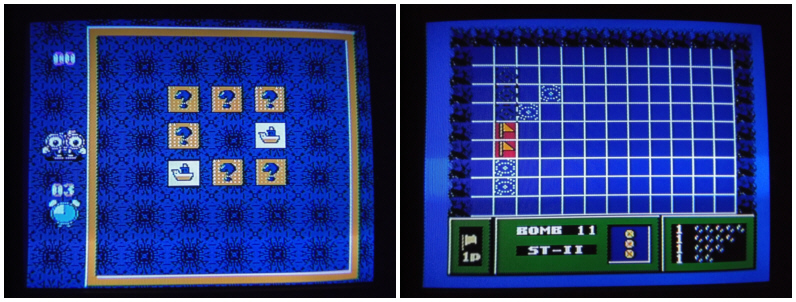
Twin Cards and Undersea
Arena
145. Twin Cards - At first Twin Cards doesn't seem to be too offensive of a concept. This is a simple single-player card matching game with a time limit, generally known as "Memory" to most people. What makes Twin Cards headache inducing are a few design choices that show a relative lack of competence. Most importantly the frame that shows which card is currently selected is nothing more than an extremely thin black rectangle, virtually impossible to see when over a card. The background designs start out pleasing and non-distracting but quickly become absolutely eye bleeding both in color and style. The color changes also affect the cards themselves, with some of the palette choices making match recognition more difficult than it should be. The actual images to be matched are decently illustrated and have some tricky variations such as varying amounts of spotted toadstools. The time limits imposed for each stage get absolutely ridiculous however and along with the crazy color changes, the game starts to feel like some kind of torture test. With that said there are some things I do like about Twin Cards, namely that there are a variety of card backs that seem to be loaded at random, which does add a little visual interest. These vary from question marks, to little rabbits, to even Mickey Mouse. There are also two starting difficulties, the later beginning the game at the ridiculous stage 40. Control is also very fast and accurate but suffers from the Nice Code problem of directional input becoming locked if a button is held down, so be sure to tap the B Button when flipping cards to prevent from becoming hung up. If a little more time was put into color choices and the time limit was relaxed just a bit this would be a nice little diversion. As it stands, there is more frustration here than enjoyment.
146. Undersea Arena - Another title we've seen before, Undersea Arena is a rework of Bug's War that takes place underwater instead of in a garden. What I find strange is it seems you're still hunting for vermin, this time what appear to be eels or slugs. Everything is exactly the same as Bug's War, featuring limited stock special bomb spreads that can uncover multiple spaces at a time. These can also be useful for quickly taking out a confirmed target. While Bug's War had a reasonably interesting garden pest extermination motif to it, Undersea Arena feels very uninspired and bland. Ultimately the game is boring for the same reason Bug's War was - it essentially boils down to a game of single player non-competitive Battleship.
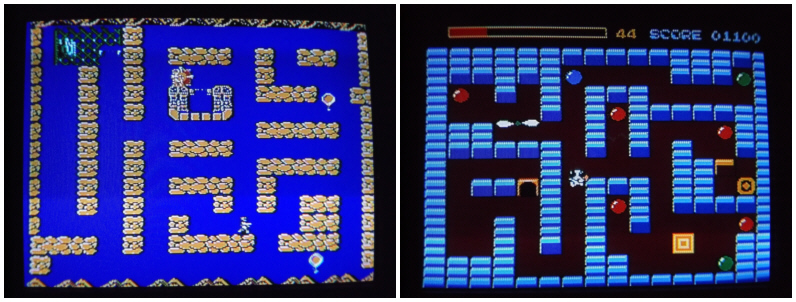
Warrior and Abscondee
147. Warrior - I know I'm going to regret thinking it shortly after, but Warrior has a very nice piece of music on its title screen, reminiscent of a military march or anthem. The game itself is yet another rework of Nice Code's conversion of the Intellivision game Night Stalker, however this one has far more visual appeal than Devildom Doom. That doesn't mean it's a good game or anything because it's just as boring as that earlier title was. Instead of robots like in Night Stalker now you're battling against tanks and what appear to be yellow balloons. One of the tanks is has an absolutely ridiculous design with a cannon pointing in each of the four cardinal directions. The other type of tank looks directly lifted from Namco's Battle City - a game that I would much rather play than this mess. Your soldier must pick up a gun to gain the ability to shoot, which becomes depleted after six shots, causing another gun to appear somewhere in the maze. Sure this is a very old game and more of an arcade-style score challenge, but something was definitely lost in the translation to the Famicom hardware. While not horrendous, and far more appealing than Devildom Doom, it still pales even in comparison to the Intellivision original of which it spawned from.
148. Abscondee - This is a pretty interesting one! Abscondee is yet another maze game that revolves around collecting all the objects on the screen but the difference here is visual presentation and style. The player controls a little alien, modeled after a traditional Gray, who has a bag slung over his shoulder like a common burglar. He must collect all the colored balls in a stage while avoiding traps that lay in wait. Additionally switches must be pressed to open doors and after all the colored balls are collected, the exit must be reached to complete a stage. Everything is very colorful and reasonably detailed and while the control isn't perfect, it's relatively easy to move around the maze. However there are some pretty big problems with Abscondee that ultimately make the game nearly unplayable. The first issue is that of the traps, which are incredibly unpredictable and seem to function at random after the little Gray approaches them. Thankfully there's a health meter but it only takes a few seconds to be in contact with a trap for it to be depleted completely. The second issue is the time limit, which is far too short to allow any finesse in completing a stage. These issues work hand in hand to destroy any fun that may be had, as you'll waste precious time waiting for a trap to stop moving, only to make a quick dash and get hit by it anyway. The music is also horrible, even for a Nice Code game.
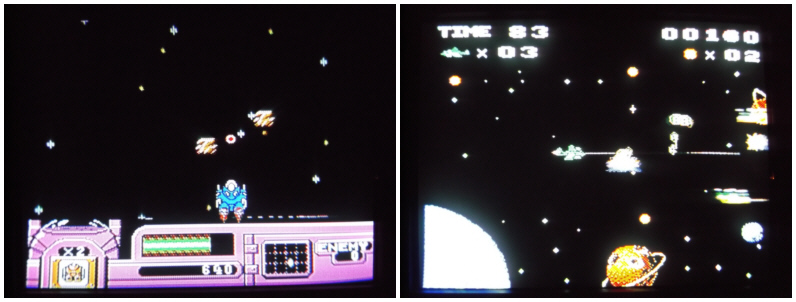
Aether Cruiser and Aim
Cruise
149. Aether Cruiser - I had high hopes for this game, as I read that Aether Cruiser is apparently a rework of Nice Code's conversion of the Atari 2600 game Solaris. Now Solaris is one of my favorite Atari 2600 games, a title that had a late release, and is easily one of the most ambitious and detailed Atari 2600 games ever created. Solaris on the Famicom, Aether Cruiser is not. Instead it plays like a fairly standard and jittery space combat game that requires little more than shooting constantly and moving back and forth. What I find most humorous about the whole thing is that Solaris is actually a better looking game with far more consistently detailed graphics. Now if I am to put the Solaris connection out of my mind, I still really don't care for Aether Cruiser, as there is very little to it and you never seem to be really doing anything worthwhile to an eventual cause. Sure you'll be shooting enemy ships and asteroids and there's a lot going on, but there's never any sort of objective to fighting through waves and waves of enemies that come and go in the blink of an eye. Perhaps this game was severely cut down from the title it was originally but as it stands the whole thing feels completely throwaway.
150. Aim Cruise - Like something out of an L. Ron Hubbard science fiction story, Aim Cruise is a space shooter that features airplanes and helicopters. The player controls a green airplane that can move in eight directions and fire forward to the left or right with the A Button. Enemy helicopters, and what appear to be robots, fly across the screen from the left and right sides. When destroyed, enemies drop floating "A" coins and collecting thirty of them will grant the player an extra life. None of this seems to matter however as there is a timer that is constantly ticking down from ninety-nine seconds at the beginning of the game. Regardless of how well you are doing, which level you are on, or how many extra ships you have in reserve, when the timer reaches zero it is game over. This means that Aim Cruise is more or less a ninety-nine second high score time attack. While this sounds disappointing, the game itself really isn't all that fun. Movement is limited to a small band across the center of the screen with no visible boundaries. This means you can often get stuck on the top or bottom edge when an enemy is closing in. The music is among some of the worst I've heard from Nice Code, made up of eight back and forth chimes along with some background percussion. While it seems like there could be something here, Aim Cruise feels like a half-completed idea.
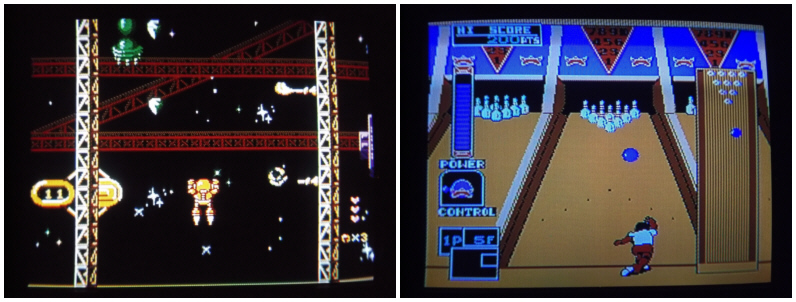
Zoom and Championship
Bowling
154. Zoom - Sporting a nice title
screen and reasonably inoffensive music, Zoom is a vertical scroller
that may remind some of Star Soldier, except with no shooting. Yes,
this is another "avoid enemies and collect items for points" game in the
vein of Pobble and Motoboat. That's really kind of a shame because
obviously a lot more work was put into Zoom with its cute robot player
character, enemies that have a bit of personality, and background graphics
that are genuinely nice to look at. The visual style reminds me of
early NES Capcom games, as does the all-too-short musical theme that plays
throughout. To me that little tune actually sounds like something
from Capcom's Little Nemo, or at least a short part of a tune that would
be right at home in that game. Guide your little robot through hazards
both environmental and offensive, collecting green gems for points.
Along the left side of the background scaffolding, distance markers pass
by letting you know how much farther you have to go until the end of the
stage. It's that "space scaffolding" look that reminds me of the
Star Soldier series and makes me wish this was a conventional shooter.
I feel Nice Code missed a great opportunity here to make a solidly entertaining
shooter, instead rolling back to their conventions and creating another
game based around dodging and collecting. In terms of pure presentation
however, this has to be one of my favorite titles of theirs included on
the multicart.
CoolBoy 400 in 1 Real Game, Spotlight Selection:
078. Bowling - While the Famicom played host to a few bowling titles, only one was localized for release on the NES. Developed by Athena and released by Romstar on the NES in 1989, Championship Bowling is that game. Sometimes all one needs with a simple concept is solid execution and Championship Bowling does just that, playing similar to the trackball bowing games once popular in arcades and bars. Left and Right on the directional pad position the bowler, then pressing the A Button sets them into place. The "control" meter then begins to automatically move left and right over an illustration of a ball, and is set in place by pressing the A Button once again. This sets the angle in which the ball will be thrown, essentially the spin your bowler will put on their release. After that then the "power" meter fills and empties, stopped by pressing the A Button to set the strength of the throw. Higher power will force harder pin action, while lower power will lend more of a hook to a ball thrown at an angle. After these options are sequentially set into place the bowler will step up and release his or her bowling ball onto the lane. Although this all seems rather simple, the extra tweaks to the basic input scheme are what make Championship Bowling play wonderfully. The game features four different bowlers to select from, each with different tendencies that affect their ball control. There are also five different ball weights to choose from, which behave differently depending on the bowler who is throwing them, in addition to having different pin action dynamics. Which of the five lanes that are bowled on also affects all of these variables, as each one is oiled differently, giving them all different sweet spots and subtleties.
So we have a solid control scheme, a great number of variables that affect ball movement and pin action, and an assortment of different lanes to play on, each with differing characteristics. In addition to the variety on display in the game play department, Championship Bowling also features a colorful and fun visual design. Everything is nicely detailed and brightly colored. The bowling alley itself has a proper perspective with easy to read input meters in addition to featuring an overhead view of ball and pin position to the right of the screen. Each of the four bowlers has a different visual design both on the selection screen and on the lane, and all have an appropriate release and follow-through animations. Extra personality is put into the strike and successive strike celebration animations, my favorite being a turkey that occasionally runs across the lanes after three consecutive strikes, known as a "turkey" in bowling. In addition to the pleasing visuals, Championship Bowling also features upbeat music from the moment the game is turned on. Granted there are only a few musical tracks throughout the entire game, and the same piece of music plays continuously while bowling regardless of the lane you are on, but damn if it doesn't put me in the mood to play this game! Sound effects, from the "voob" of the input meters, to the hum of the ball spinning down the lane, to the crash of the pins, are all very nice as well.
Championship Bowling is one of those unique
four-player NES games that only requires two standard Control Pads with
no additional accessories. In a four-player game, players one and
three use the first controller, while players two and four use the second.
Control is simply handed back and forth between players and due to the
staggered arrangement of 1-3 and 2-4, the next bowler can play unhindered
while the previous player is passing the other controller off to the player
who will come next. I received Championship Bowling as a Christmas
gift, in 1991 I believe, and my NES was soon brought out into the living
room to make use of this feature. It was the first Christmas in our
new home since my immediate family had relocated out of Silicon Valley,
and a time everyone came out and was together. I would have been
about ten-years-old at the time and can remember everyone spending hours
playing Championship Bowling over a couple days that Christmas, an instant
hit in what I suppose could be classified as a bowling family. It
is a game I ever grew tired of and still greatly enjoy to this day.
This is also a great NES game with wide appeal that isn't often talked
about but that should really change because it's a lot of fun and very
accessible.
Okay, next time it's back to business as
usual with the standard cargo of fifteen games. We'll step back to
collect games we jumped over to get to the Nice Code titles, grabbing games
number 091 and 093 - 097, then picking up at 151 - 153, hopping over to
155, then continuing forward until we fill our fifteen title invoice.
Those fifteen titles will be a diverse mix including all the Donkey Kong
NES games, a shooter that was the absolute pinnacle of the genre on the
Famicom when it was released, a vehicular shooter everyone but me seems
to love, a superhero game no one likes, and a pretty insane Famicom release
that was localized to be an equally bizarre game on the NES. See
you then!
|
Every Friday on The Retrogaming Times Facebook page (facebook.com/theretrogamingtimes), we present a Weekly Retrogaming Trivia question. This just-for-fun trivia challenge provided each week is an opportunity to test your arcane and oddball retrogaming knowledge. The answer to the question from the previous week is posted along with a new trivia question every Friday!
Below is the recap of all questions and
answers posted between this issue and the previous issue:
02/24/2017 - WEEK 5
Question: What game
contained the first appearance of Sonic the Hedgehog?
03/03/2017 - WEEK 6
Question: In the Japanese
version of Fighting Vipers (Saturn) what hidden character can be unlocked
that is NOT included in the USA release?
03/10/2017 - WEEK 7
Question: What was the
first multiplayer, multi-cabinet networked arcade racing game?
03/17/2017 - WEEK 8
Question: The Punch-Out!!
theme is based on an advertising jingle, once synonymous with boxing, for
what company?
03/24/2017 - WEEK 9
Question: What other
Konami games are advertised during an intermission in the NES game Blades
of Steel?
03/31/2017 - WEEK 10
Question: Arcade developer
Gazelle, one of the companies born from the closure of Toaplan, only developed
two arcade games - what were their titles?
04/07/2017 - WEEK 11
Question: What were
the two HuCARD / TurboChip games Working Designs published for the TurboGrafx-16?
04/14/2017 - WEEK 12
Question: In Cyber Troopers
VirtualOn, the design of virtualoid Fei-Yen is based on what anime / manga
character?
04/21/2017 - WEEK 13
Question: What Game
Boy Advance remake of an NES game has a Toys 'R' Us parody shop called
"Toys 'B' We?"
Answers:
Week 5 Answer: The arcade racer
"Rad Mobile," as a charm hanging from the rear view mirror.
Week 6 Answer: Pepsiman.
Week 7 Answer: Final Lap, released
by Namco in 1987.
Week 8 Answer: Gillette, the "Look
Sharp, Be Sharp" march.
Week 9 Answer: Jackal and Contra.
Week 10 Answer: Pretty Soldier Sailor
Moon / Bishoujo Senshi Sailor Moon (1995) and Air Gallet (1996).
Week 11 Answer: Cadash and Parasol
Stars.
Week 12 Answer: Sailor Moon.
Week 13 Answer: River City Ransom
EX.
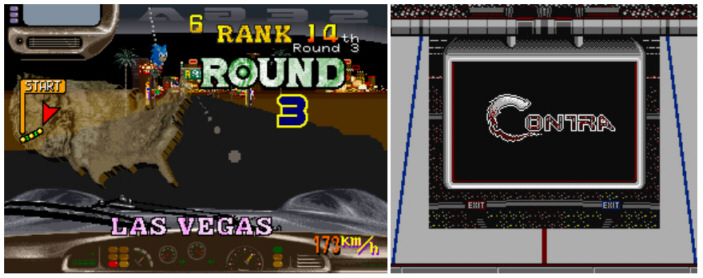
Sonic the Hedgehog in
Rad Mobile (left), Contra advertisement during second intermission in Blades
of Steel (right)
Don't be left out! Be sure to follow The Retrogaming Times on Facebook for a new retrogaming trivia question every Friday!
We need your questions! If
you have a trivia question you would like to submit for possible inclusion
in the Weekly Retrogaming Trivia question pool, e-mail it to trt@classicplastic.net!
|
As these issues have rolled out, I've come to notice the majority of the time when writing this closing I am directly inspired by the content our contributors submit. Thinking about the Sega Genesis and how Sega's home console business is perceived specifically, brought to mind how much the success or failure of a piece of hardware used to depend more on how your business competition handled itself and regional perspective. When the Sega Genesis was originally launched in Japan as the Mega Drive in late 1988, it was initially met with very little fanfare, and would ultimately fail to even reach the Famicom's level of popularity in that region. Additionally NEC and Hudson had beaten Sega to market in Japan a year earlier in 1987 with their PC Engine, later rebranded outside of Japan as the TurboGrafx-16, ushering in the next generation of console video games. The PC Engine would prove to be extremely successful in Japan, and why wouldn't it be? With its beautiful colors, impressive sound, and technology that was a massive step forward from the Famicom's 1983 design, regardless of what fancy custom hardware Famicom developers were packing into their cartridges. When the Mega Drive was stumbling out of the gate in Japan, the PC Engine was receiving a CD-ROM add-on, way back in 1988 before even audio CD players were widely commonplace.
After abysmal marketing helped sink the Sega Master System in the USA before it could even get going, and possibly seeing that the Japanese market of the era was more or less lost to them in the wake of the PC Engine's new success and the Famicom's established sales, Sega doubled down in America with a radical and aggressive advertising campaign pointed directly at the aging NES. Their boldness worked and the Sega Genesis eventually became a massive success in North America. In the West it was NEC who had dropped the ball this time, actually releasing the TurboGrafx-16 two weeks after the Sega Genesis in the region, even though their hardware originally had a one-year head start. While two weeks shouldn't have mattered that much in the grand scheme of things, it was NEC this time had the abysmal marketing and poor software selections. While the PC Engine had tons of outstanding games in Japan such as many incredible and popular RPGs, it was just before the anime boom and the subsequent explosion of Japanese culture into the mainstream outside of Japan. A few of these titles would eventually make the trip across the Pacific yet the vast majority of them never left Japan, attributed to being a poor match for the western audience of the time. When the Super Famicom finally arrived in Japan it more or less closed the door on the Mega Drive in that region, alternately doing the same for the TurboGrafx-16 in North America a year later, rebranded as Super Nintendo. While Nintendo may not have had the complete sales lead in every nation, they did have the one thing the other hardware developers lacked - top-level global market share. Sega concentrated their home gaming efforts on North America, carving out a majority of the market in that region with the massive success of their Genesis. At the same time NEC and Hudson continued to concentrate on Japan, carving out their own healthy share of the Japanese market with their PC Engine and its expansions. As another interesting and incredible example of regional perspective, the Master System actually found solid success in Europe and would go on to be the dominate video game console in Brazil, where it still holds a measure of market share to this day.
The mistakes of NEC with the TurboGrafx-16 and the successes of Sega with the Genesis in North America always bring the same "what if" scenario to my mind. What if NEC had come out of the gate charging into the international market just a few months after the release of the PC Engine? What if it was decided that The Legendary Axe would be the pack-in title, a game that more or less had the widest and most impressive appeal of the early TurboGrafx-16 launch titles, rather than a rework of a mediocre licensed game localized as Keith Courage in Alpha Zones? What if the outstanding PC Engine home conversion of Street Fighter II had an American release, a game that would have been an absolute system seller at the time? What if more companies were willing to take the risk and put forth the money to localize more of the expansive and impressive PC Engine RPGs? If just one of those things were different, we may very well have been playing an NEC or Hudson developed console to this day. What's your opinion on a video game industry "what if?" Let us know on Facebook or send me an e-mail.
Thank you once again for reading The Retrogaming Times. We'll be back on July 1st with our next issue. Be sure to follow The Retrogaming Times on Facebook and join our new community! I sincerely hope you enjoyed this issue and that you will return to read the next issue and possibly submit an article yourself. Remember, this newsletter can only exist with your help. Simply send your articles directly to me at trt@classicplastic.net or check out the submission guidelines on the main page. Submit an article today and join a great retrogaming tradition!
See You Next Game!

Content and opinions on this
page are those of their respective writer(s)
Assembled and published
by David Lundin, Jr. on May 1st, 2017 at ClassicPlastic.net
© 2017 The Retrogaming
Times. All Related Copyrights and Trademarks Are Acknowledged.